Paper Menu >>
Journal Menu >>
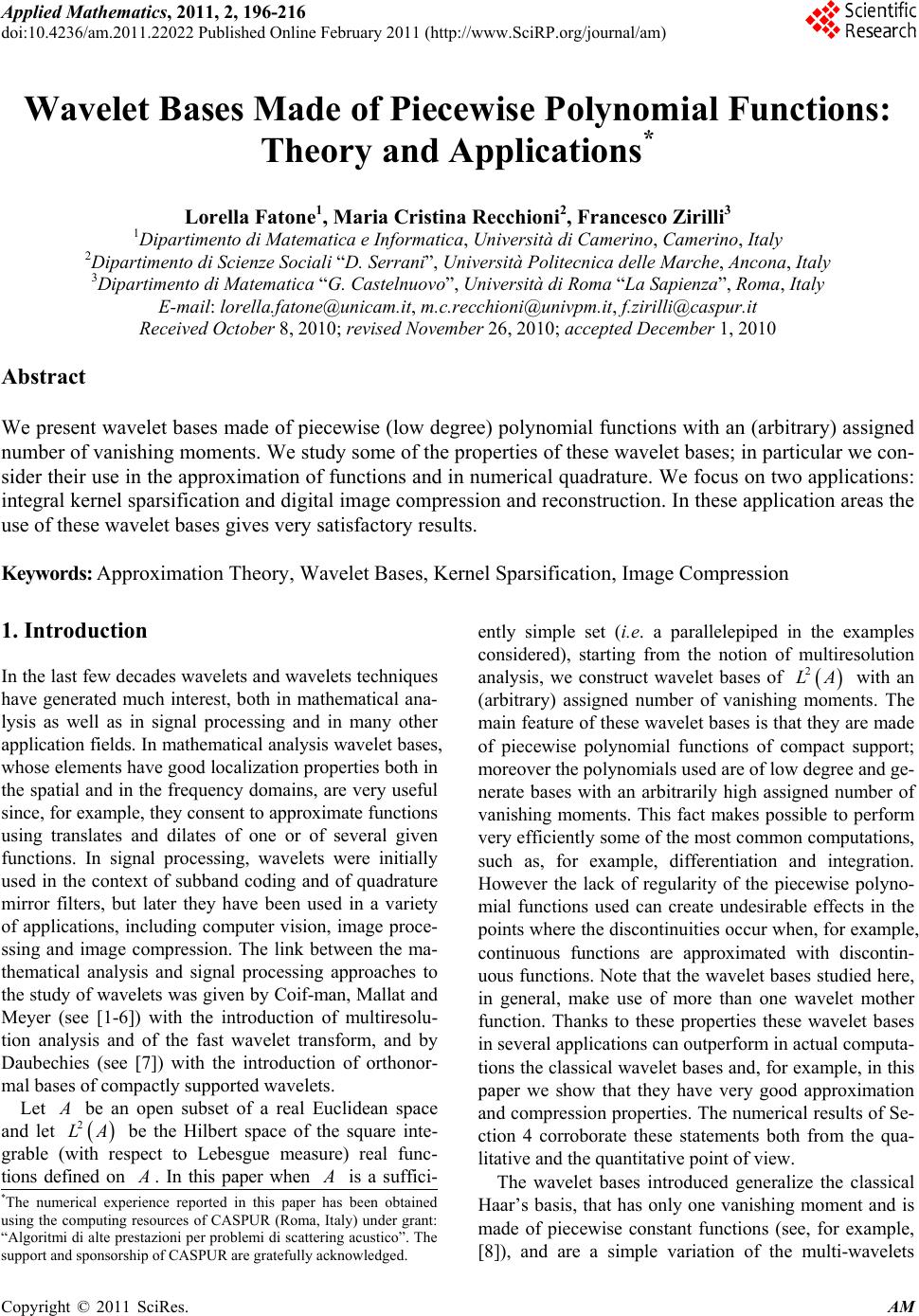 Applied Mathematics, 2011, 2, 196-216 doi:10.4236/am.2011.22022 Published Online February 2011 (http://www.SciRP.org/journal/am) Copyright © 2011 SciRes. AM Wavelet Bases Made of Piecewise Polynomial Functions: Theory and Applications* Lorella Fatone1, Maria Cristina Recchioni2, Francesco Zirilli3 1Dipartimento di Matematica e Informatica, Università di Camerino, Camerino, Italy 2Dipartimento di Scienze Sociali “D. Serrani”, Università Politecnica delle Marche, Anco na, Italy 3Dipartimento di Matematica “G. Castelnuovo”, Università di Roma “La Sapienza”, Roma, Italy E-mail: lorella.fatone@unicam.it, m.c.recchioni@univpm.it, f.zirilli@caspur.it Received October 8, 2010; revised November 26, 2010; accepted Dece mb er 1, 2010 Abstract We present wavelet bases made of piecewise (low degree) polynomial functions with an (arbitrary) assigned number of vanishing moments. We study some of the properties of these wavelet bases; in particular we con- sider their use in the approximation of functions and in numerical quadrature. We focus on two applications: integral kernel sparsification and digital image compression and reconstruction. In these application areas the use of these wavelet bases gives very satisfactory results. Keywords: Approximation Theory, Wavelet Bases, Kernel Sparsification, Image Compression 1. Introduction In the last few decades wavelets and wavelets techniques have generated much interest, both in mathematical ana- lysis as well as in signal processing and in many other application fields . In mathematical analysis wav elet bases, whose elements have good localization properties both in the spatial and in the frequency domains, are very useful since, for example, they consent to approximate functions using translates and dilates of one or of several given functions. In signal processing, wavelets were initially used in the context of subband coding and of quadrature mirror filters, but later they have been used in a variety of applications, including computer vision, image proce- ssing and image compression. The link between the ma- thematical analysis and signal processing approaches to the study of wavelets was given by Coif-man, Mallat and Meyer (see [1-6]) with the introduction of multiresolu- tion analysis and of the fast wavelet transform, and by Daubechies (see [7]) with the introduction of orthonor- mal bases of compactly supported wavelets. Let A be an open subset of a real Euclidean space and let 2 LA be the Hilbert space of the square inte- grable (with respect to Lebesgue measure) real func- tions defined on A . In this paper when A is a suffici- ently simple set (i.e. a parallelepiped in the examples considered), starting from the notion of multiresolution analysis, we construct wavelet bases of 2 LA with an (arbitrary) assigned number of vanishing moments. The main feature of these wavelet bases is that they are made of piecewise polynomial functions of compact support; moreover the polynomials used are of low degree and ge- nerate bases with an arbitrarily high assigned number of vanishing moments. This fact makes possible to perform very efficiently some of the most common computations, such as, for example, differentiation and integration. However the lack of regularity of the piecewise polyno- mial functions used can create undesirable effects in the points where the disco ntinuities o ccur when, for example, continuous functions are approximated with discontin- uous functions. Note that the wavelet bases studied here, in general, make use of more than one wavelet mother function. Thanks to these properties these wavelet bases in several applications can outperform in actual computa- tions the classical wavelet bases and, for example, in this paper we show that they have very good approximation and compression properties. The numerical results of Se- ction 4 corroborate these statements both from the qua- litative and the quantitative point of view. The wavelet bases introduced generalize the classical Haar’s basis, that has only one vanishing moment and is made of piecewise constant functions (see, for example, [8]), and are a simple variation of the multi-wavelets *The numerical experience reported in this paper has been obtained using the computing resources of CASPUR (Roma, Italy) under grant: “Algoritmi di alte prestazioni per problemi di scattering acustico”. The su pp ort and s p onsorshi p of CASPUR are g ratefull y acknowled g ed. 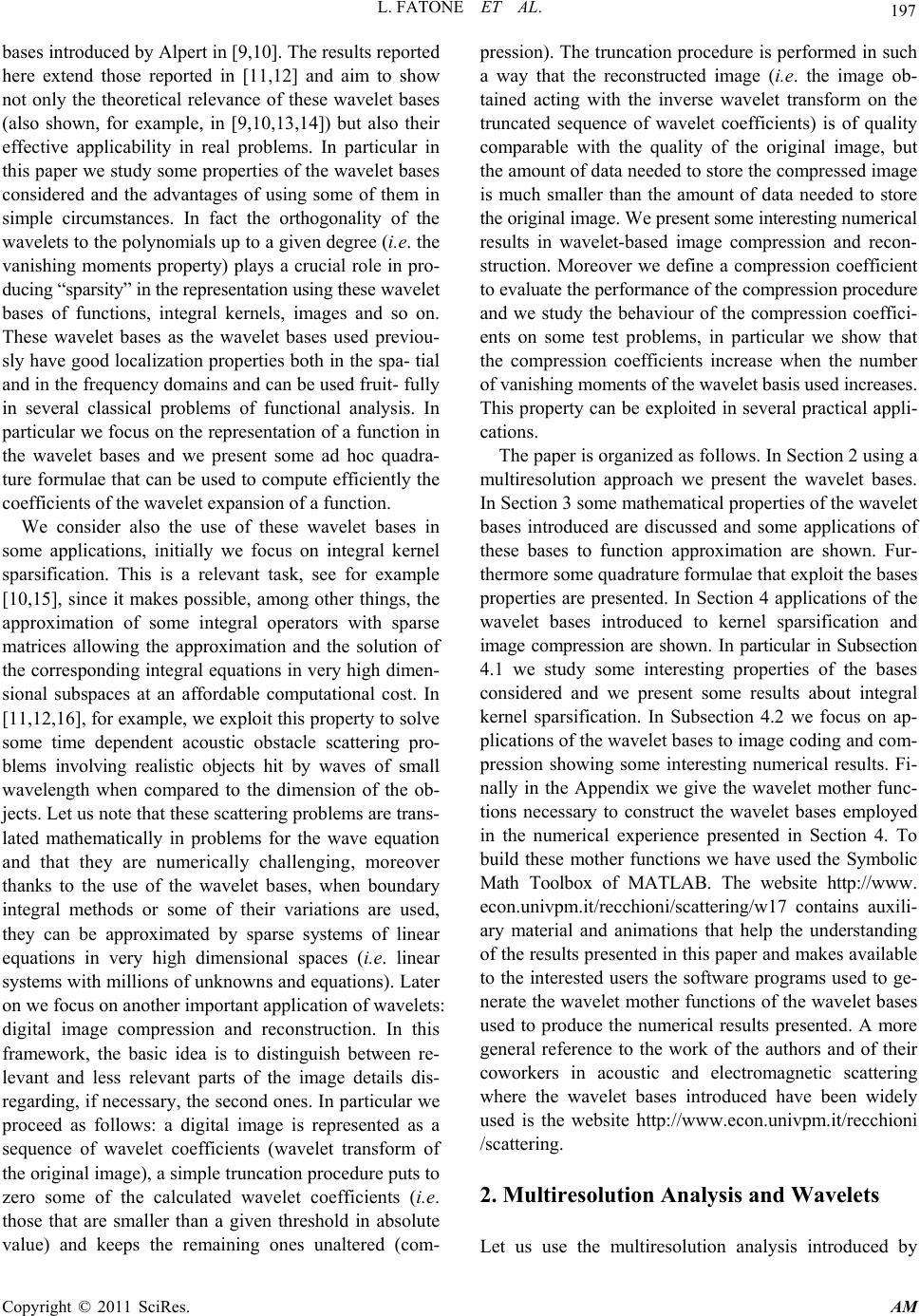 L. FATONE ET AL. Copyright © 2011 SciRes. AM 197 bases introduced by Alpert in [9,10]. The results reported here extend those reported in [11,12] and aim to show not only the theoretical relevance of these wavelet bases (also shown, for example, in [9,10,13,14]) but also their effective applicability in real problems. In particular in this paper we study some properties of the wavelet bases considered and the advantages of using some of them in simple circumstances. In fact the orthogonality of the wavelets to the polynomials up to a given degree (i.e. the vanishing moments property) plays a crucial role in pro- ducing “sparsity” in the representation using these wav elet bases of functions, integral kernels, images and so on. These wavelet bases as the wavelet bases used previou- sly have good localizatio n properties both in the spa- tial and in the frequency domains and can be used fruit- fully in several classical problems of functional analysis. In particular we focus on the representation of a function in the wavelet bases and we present some ad hoc quadra- ture formulae that can be used to compute efficiently the coefficients of the wavelet expansion of a function. We consider also the use of these wavelet bases in some applications, initially we focus on integral kernel sparsification. This is a relevant task, see for example [10,15], since it makes possible, among other things, the approximation of some integral operators with sparse matrices allowing the approximation and the solution of the corresponding integral equations in very high dimen- sional subspaces at an affordable computational cost. In [11,12,16], for example, we exploit this property to solve some time dependent acoustic obstacle scattering pro- blems involving realistic objects hit by waves of small wavelength when compared to the dimension of the ob- jects. Let us note that these scattering problems are trans- lated mathematically in problems for the wave equation and that they are numerically challenging, moreover thanks to the use of the wavelet bases, when boundary integral methods or some of their variations are used, they can be approximated by sparse systems of linear equations in very high dimensional spaces (i.e. linear systems with millions of unknowns and equatio ns). Later on we focus on another important application of wavelets: digital image compression and reconstruction. In this framework, the basic idea is to distinguish between re- levant and less relevant parts of the image details dis- regarding, if necessary, the second ones. In particular we proceed as follows: a digital image is represented as a sequence of wavelet coefficients (wavelet transform of the original image), a simple truncation procedure puts to zero some of the calculated wavelet coefficients (i.e. those that are smaller than a given threshold in absolute value) and keeps the remaining ones unaltered (com- pression). The truncation pro cedure is performed in su ch a way that the reconstructed image (i.e. the image ob- tained acting with the inverse wavelet transform on the truncated sequence of wavelet coefficients) is of quality comparable with the quality of the original image, but the amount of data needed to store the compressed image is much smaller than the amount of data needed to store the origina l i mag e. W e pr esent some inter esti n g numer i cal results in wavelet-based image compression and recon- struction. Moreover we define a compression coefficient to evaluate the performance of the compression procedure and we study the behaviour of the compression coeffici- ents on some test problems, in particular we show that the compression coefficients increase when the number of vanishing moments of the wavelet basi s used increases. This property can be exploited in several practical app li- cations. The paper is organized as follows. In Section 2 using a multiresolution approach we present the wavelet bases. In Section 3 some mathematical properties of the wavelet bases introduced are discussed and some applications of these bases to function approximation are shown. Fur- thermore some quadrature formulae that exploit the bases properties are presented. In Section 4 applications of the wavelet bases introduced to kernel sparsification and image compression are shown. In particular in Subsection 4.1 we study some interesting properties of the bases considered and we present some results about integral kernel sparsification. In Subsection 4.2 we focus on ap- plications of the wavelet bases to image coding and com- pression showing some interesting numerical results. Fi- nally in the Appendix we give the wavelet mother func- tions necessary to construct the wavelet bases employed in the numerical experience presented in Section 4. To build these mother functions we have used the Symbolic Math Toolbox of MATLAB. The website http://www. econ.univpm.it/recchioni/scattering/w17 contains auxili- ary material and animations that help the understanding of the results presented in this paper and makes availab le to the interested users the software programs used to ge- nerate the wavelet mother fun ctions of the wavelet bases used to produce the numerical results presented. A more general reference to the work of the authors and of their coworkers in acoustic and electromagnetic scattering where the wavelet bases introduced have been widely used is the website http://www.econ.univpm.it/recchioni /scattering. 2. Multiresolution Analysis and Wavelets Let us use the multiresolution analysis introduced by  L. FATONE ET AL. Copyright © 2011 SciRes. AM 198 Mallat [1,2], Meyer [3-5] and Coifman and Meyer [6] to construct wavelet bases. Let us begin introducing some notation. Let Rbe the set of real numbers, given a posi- tive integer s let s R be the s-dimensional real Eucli- dean space, and let 12 =,,,T s s x xx xR be a gene- ric vector where the superscript T means transposed. Let (,) and denote the Euclidean scalar product and the corresponding Euclidean vector norm respecti- vely. For simplicity we restrict our analysis to the interval (0,1). More precisely, we choose =0,1 A R. Let 20,1L be the Hilbert space of square integrable (with respect to Lebesgue measure) real functions de- fined on the interval (0,1). We want to construct ortho- normal wavelet bases of 20,1L via a multiresolu- tion method similar to the methods used in [9,1-6]. Note that using the ideas suggested in [13,14] it is possible to generalize the work presented here to rather general do- mains A in dimension greater or equal to one. Given an integer 1,M we consider the following decomposition of 20,1L: 20,1=0,10,1 , MM LP V (1) where denotes the direct sum of two orthogonal closed subspaces 0,1 M P and 0,1 M V of 20,1L. In other words, the vector space generated by the union of 0,1 M P and 0,1 M V is 20,1L and we have: 1 0=0,0,1,0,1 . MM dx fxgxfPgV (2) We take 0,1 M P to be the space of the poly- nomials of degree smaller than M define d on (0,1) and we consider a basis of 0,1 M P made of M polyno- mials orthogonal in the interval (0,1) with respect to the weight function =1,wx 0,1 ,x having 2 L-norm equal to one. For example we can choose as basis of 0,1 M P the first M Legendre orthonormal polyno- mials defined on (0,1) and we refer to them as(), q Lx (0,1),x =0,1, ,1qM. To construct a basis of 0,1 M V we use the ideas behind the multiresolution analysis. Let us begin d efining the so called “wavelet mother functions”. Let 2N be an integer and let 1 12 1 =,,, T NN NR be a vector whose elements 0,1 ,=1,2,,1, iiN are such that 1 <,=1,2,, 2 ii ηη iN . Given the integers J, M, N, such that 1,J 1,M 2,Nwe define the following piecewise polynom ial functions o n (0 ,1): 1 1, ,, 1 ,, 1,,, 1 ,, , (),(0, ), ()=(),[,),=1,2,,2, (),[ ,1), MN jN MM NNii jNi jN MNN NjN pxx xp xxiN pxx =1,2,, ,jJ (3) where 1 =0 ,, ,,,,, , =0,1, M MlM NN l ijNlijMN px qxP =1,2,, ,iN =1,2,, ,jJ are polynomials of degree smaller than M to be determined. The functions ,, , M N jN =1,2,, ,jJ defined in (3) will be used as “wavelet mother functions”. In fact through them we generate the elements of a wavelet family via the multiresolution analysis. For simplicity let us choose =/ , iiN =i 1,2,, 1N . We note that results analogous to the ones obtained here with this choice can be derived for the general choice of , i =1,2,,1,iN at the price of having more involved formulae. Let us define the functions: 2 ,, ,,,, , =,1 , 0,0,1 \,1, mMm N jN Mmm N jm N mm NNx xxNN xNN =0,1,, 1,=0,1,,=1,2,,, m Nm j J (4) whose supports are the intervals ,1 mm NN 0,1 ,=0,1, ,1, m N =0,1,m. Moreover we define the set of functions ,, 0,1 MN NJ W as follows: ,, ,,,, 0,1=,0,1,= 0,1,,1, ,(0,1),=1,2,, , =0,1, ,=0,1, ,1, MNq NJ MN jm N m WLxxqM xx jJ mN (5) where , q Lx =0,1,,1,qM and ,, (), MN jN x 0,1 ,x =1,2,,,jJ are the functions defined above when we c hoose =1,2,3, ,1T NNNNN N . We want to choose J , M , N, and the coefficients of the polynomials that constitute the functions ,, , M N jN =1,2,, ,jJ defined in (3), that is the coefficients ,,,,,N li jM N q , =0,1, ,1lM, of ,, , M N ijN p , =1,2, ,jJ, =1,2,, ,iN in order to guarantee that the set ,, 0,1 MN NJ W defined in (5) is an orthonormal basis of 20,1L. This can be done when J, M, N 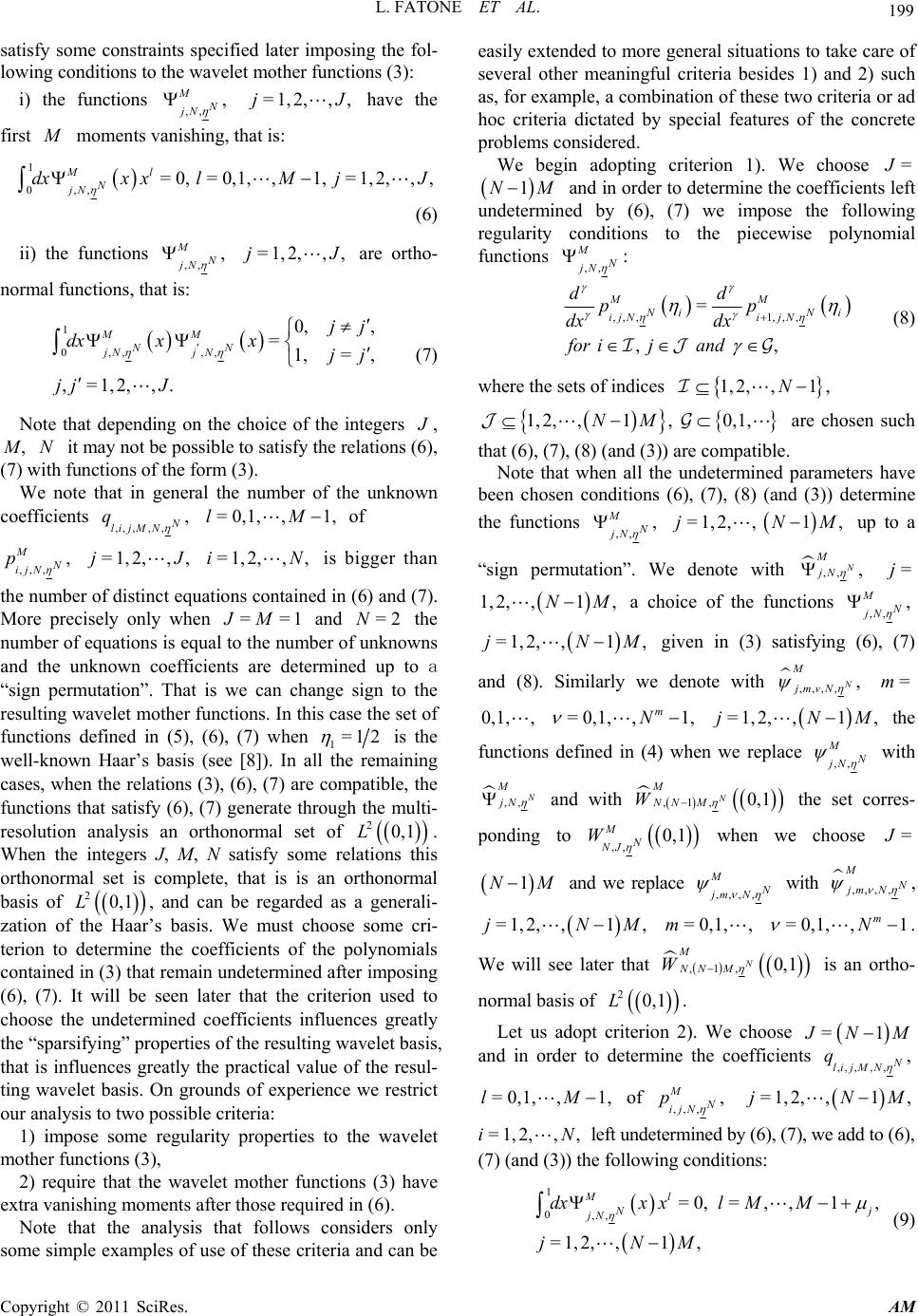 L. FATONE ET AL. Copyright © 2011 SciRes. AM 199 satisfy some constraints specified later imposing the fol- lowing conditions to the wavelet mother functions (3): i) the functions ,, , M N jN =1,2,, ,jJ have the first M moments vanishing, that is: 1 0,, =0,= 0,1,,1,=1,2,,, Ml N jN dxxxlMjJ (6) ii) the functions ,,, M N jN =1,2,,,jJ are ortho- normal functions, that is: 1 0,, ,, 0, , =1,= , ,=1,2,,. MM N' N jN jN jj dx xxjj jj J (7) Note that depending on the choice of the integers J , M , N it may not be possible to satisfy the relations (6), (7) with func tio ns of the form (3). We note that in general the number of the unknown coefficients ,, ,,,, N li jM N q =0,1,,1,lM of ,, ,, M N ijN p =1,2,, ,jJ =1,2,,,iN is bigger than the number of distinct equations contained in (6) and (7). More precisely only when ==1JM and =2N the number of equations is equal to the number of unknowns and the unknown coefficients are determined up to a “sign permutation”. That is we can change sign to the resulting wavelet mother functions. In this case the set of functions defined in (5), (6), (7) when 1=12 is the well-known Haar’s basis (see [8]). In all the remaining cases, when the relations (3), (6), (7) are compatible, the functions that satisfy (6), (7) generate through the multi- resolution analysis an orthonormal set of 20,1L. When the integers J, M, N satisfy some relations this orthonormal set is complete, that is is an orthonormal basis of 20,1L, and can be regarded as a generali- zation of the Haar’s basis. We must choose some cri- terion to determine the coefficients of the polynomials contained in (3) that remain undetermined after imposing (6), (7). It will be seen later that the criterion used to choose the undetermined coefficients influences greatly the “sparsifying” properties of the resulting wavelet basis, that is influences greatly the practical value of the resul- ting wavelet basis. On grounds of experience we restrict our analysis to two possible criteria: 1) impose some regularity properties to the wavelet mother functions (3), 2) require that the wavelet mother functions (3) have extra vanishing moments after those required in (6). Note that the analysis that follows considers only some simple examples of use of these criteria and can be easily extended to more general situations to take care of several other meaningful criteria besides 1) and 2) such as, for example, a combination of these two criteria or ad hoc criteria dictated by special features of the concrete problems considered. We begin adopting criterion 1). We choose = J 1NM and in order to determine the coefficients left undetermined by (6), (7) we impose the following regularity conditions to the piecewise polynomial functions ,, M N jN : ,, ,1,,, = ,, MM N iNi ijNijN dd pp dx dx for ijand (8) where the sets of indices 1,2,,1 ,N 1,2,,1,NM 0,1, are chosen such that (6), (7), (8) (and (3)) are compatible. Note that when all the undetermined parameters have been chosen conditions (6), (7), (8) (and (3)) determine the functions ,,, M N jN =1,2,,j 1,NM up to a “sign permutation”. We denote with ,, , N M jN =j 1,2,,1,NM a choice of the functions ,,, M N jN =1,2,,1,jNM given in (3) satisfying (6), (7) and (8). Similarly we denote with ,,,, , N M jmvN =m 0,1, , =0,1,,1, m N =1,2,,1,jNM the functions defined in (4) when we replace ,, M N jN with ,, N M jN and with ,1,0,1 N M NNM W the set corres- ponding to ,, 0,1 MN NJ W when we choose = J 1NM and we replace ,,,, M N jm N with ,,,, , M N jm N =1,2,,1,jNM =0,1, ,m =0,1,,1 m N . We will see later that ,1,0,1 N M NNM W is an ortho- normal basis of 20,1L. Let us adopt criterion 2). We choose =1 J NM and in order to determine the coefficients ,, ,,,, N li jM N q =0,1, ,1,lM of ,,,, M N ijN p =1,2,,1,jNM =1,2,,,iN left undetermined by (6), (7), we add to (6), (7) (and (3)) the following conditions: 1 0,, =0,=, ,1, =1,2,,1, Ml N j jN dxxxlMM jNM (9) 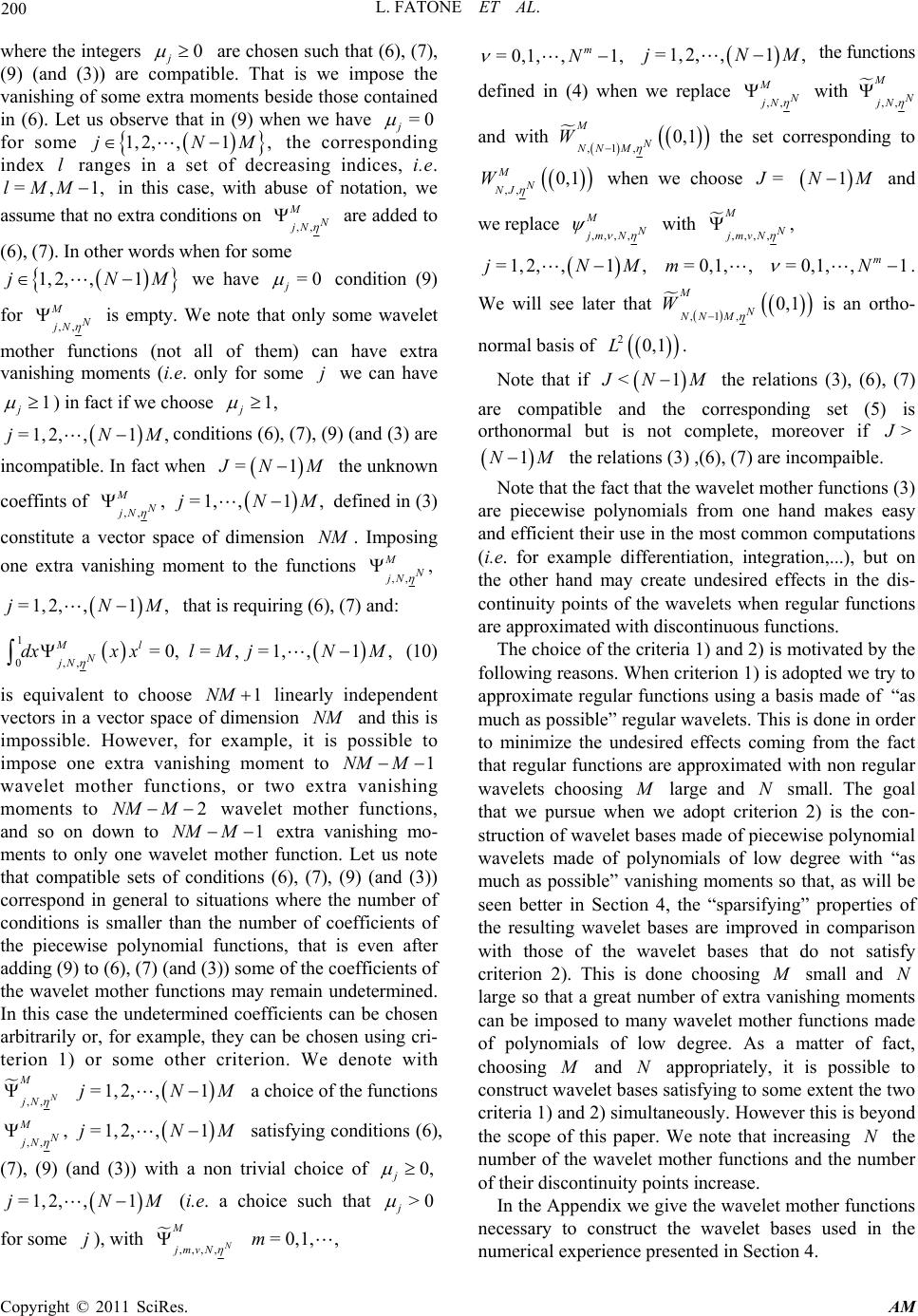 L. FATONE ET AL. Copyright © 2011 SciRes. AM 200 where the integers 0 j are chosen such that (6), (7), (9) (and (3)) are compatible. That is we impose the vanishing of some extra moments beside those contained in (6). Let us observe that in (9) when we have =0 j for some 1,2,,1,jNM the corresponding index l ranges in a set of decreasing indices, i.e. =, 1,lMM in this case, with abuse of notation, we assume that no extra conditions on ,, M N jN are added to (6), (7). In other words when for some 1,2,,1jNM we have =0 j condition (9) for ,, M N jN is empty. We note that only some wavelet mother functions (not all of them) can have extra vanishing moments (i.e. only for some j we can have 1 j ) in fact if we choose 1, j =1,2,,1,jNMconditions (6), (7), (9) (and (3) are incompatible. In fact when =1 J NM the unknown coeffints of ,, , MN jN =1, ,1,jNM define d in (3) constitute a vector space of dimension NM . Imposing one extra vanishing moment to the functions ,,, M N jN =1,2,,1,jNM that is requiring (6), (7) and : 1 0,, =0,=, =1,,1, Ml N jN dxxxlMjNM (10) is equivalent to choose 1NM linearly independent vectors in a vector space of dimension NM and this is impossible. However, for example, it is possible to impose one extra vanishing moment to 1NM M wavelet mother functions, or two extra vanishing moments to 2NM M wavelet mother functions, and so on down to 1NMM extra vanishing mo- ments to only one wavelet mother function. Let us note that compatible sets of conditions (6), (7), (9) (and (3)) correspond in general to situations where the number of conditions is smaller than the number of coefficients of the piecewise polynomial functions, that is even after adding (9) to (6), (7) (and (3)) some of th e coeff icients of the wavelet mother functions may remain undetermined. In this case the undetermined coefficients can be chosen arbitrarily or, for example, they can be chosen using cri- terion 1) or some other criterion. We denote with ,, N M jN =1,2,,1jNM a choice of the functions ,, , M N jN =1,2,,1jNM satisfying conditions (6), (7), (9) (and (3)) with a non trivial choice of 0, j =1,2,,1jNM (i.e. a choice such that >0 j for some j), with ,,, ,N M jmvN =0,1,,m =0,1, ,1, m N =1,2,,1,jNM the functions defined in (4) when we replace ,, M N jN with ,, M N jN and with ,1,0,1 M N NNM W the set corresponding to ,, 0,1 MN NJ W when we choose = J 1NM and we replace ,,,, M N jmN with ,,,, , M N jmvN =1,2,,1,jNM =0,1, ,m =0,1, ,1 m N . We will see later that ,1,0,1 M N NNM W is an ortho- normal basis of 20,1L. Note that if <1 J NM the relations (3), (6), (7) are compatible and the corresponding set (5) is orthonormal but is not complete, moreover if > J 1NM the relations (3) ,(6), (7) are incompaible. Note that the fact that the wavelet mother fun ctio ns (3) are piecewise polynomials from one hand makes easy and efficient their use in the most common computations (i.e. for example differentiation, integration,...), but on the other hand may create undesired effects in the dis- continuity points of the wavelets when regular functions are approximated wi t h disco ntinuous functi o ns. The choice of the criteria 1) and 2) is motivated by the following reasons. When criterion 1) is adopted we try to approximate regular functions using a basis made of “as much as possible” regular wavelets. This is don e in order to minimize the undesired effects coming from the fact that regular functions are approximated with non regular wavelets choosing M large and N small. The goal that we pursue when we adopt criterion 2) is the con- struction of wavelet bases made of piecewise polynomial wavelets made of polynomials of low degree with “as much as possible” vanishing moments so that, as will be seen better in Section 4, the “sparsifying” properties of the resulting wavelet bases are improved in comparison with those of the wavelet bases that do not satisfy criterion 2). This is done choosing M small and N large so that a great number of extra vanishing moments can be imposed to many wavelet mother functions made of polynomials of low degree. As a matter of fact, choosing M and N appropriately, it is possible to construct wavelet bases satisfying to some extent the two criteria 1) and 2) simultaneously. However this is beyond the scope of this paper. We note that increasing N the number of the wavelet mother functions and the number of their discontinuity points increase. In the Appendix we give the wavelet mother func tions necessary to construct the wavelet bases used in the numerical experience presented in Section 4.  L. FATONE ET AL. Copyright © 2011 SciRes. AM 201 3. Some Mathematical Properties of the Wavelet Bases Let us prove that the set of functions considered previously are orthonormal bases of 20,1L. Lemma 3.1. Let 2N be a positive in teger and , m T =m 0,1, be the following closed subspaces of 20,1L: 2 =0,1=,,1, ,= 0,1,2,,1,= 0,1,2,. mm m m TfL fxpxNN pRNm (11) Then we have: 0123 ,TTTT (12) 1 =0 =0,1, mm TP (13) 2 =0 =0,1. mm TL (14) Proof. Properties (12), (13) can be easily derived from (11). The proof of (14) follows from the density of the piecewise constant functions in 20,1L (see [17] Theorem 3.13 p. 84). This concludes the proof. Note that for =0,1, ,m the fact that m f xT implies that for =0,1, , 1 m N as a function of x for 0,1x ,0 =m m f xfNxT . Theorem 3.2. Let 1,J 1,M 2N be three integers such that the conditions (6), (7) can be satisfied with functions of the form (3) and let ,,,, , MN jm N x 0,1 ,x =1,2,, ,jJ =0,1,,m =0,1, ,1 , m N be the functions defined in (4), we have: 1 0,,,, =0, =0,1, ,1, =0,1, ,1, =0,1,,=1,2,, , Mp N jm N m dxxx pM N mjJ (15) and 1 0,,,,, ,, () () 0,oo , =1,=a= a= , =0,1, ,1,=0,1,,1, ,=0,1, ,,=1,2, ,. MM NN jmNj mN mm dx xx mmrrj j mmndndj j NN mmj jJ (16) Proof. Property (15) follows from definition (4) and Equation (6). The proof of (16) when =,mm = and jj follows from the fact that the supports of the functions ,,,, M N jm N and ,,,, M N jm N are either disjoint sets or sets contained one into the other. When =mm and the supports are disjoint and when ,mm let us suppose for example >,mm the supports are either disjoint sets or sets contained one into the other depending on the values of the indices and . In fact when the supports are disjoint condition (16) is obvious, when the supports are contained one into the other condition (16) follows from (15). Finally when =,mm =, =jj condition (16) follows from Equation (7). This concludes the proof. Note that if we choose ,,,, M N jmN = ,,,, , N M jmvN =1,2,,1,jNM =0,1, ,m =0,1, ,1, m N then (15) can be improved, that is we can add to it the following condition: 1 ,,,, 0=0, =,,1 , =0,1, ,1, =0,1,,=1,2,,1, Mp N jm N j m dxx x pMM N mj NM (17) where 0 j are the non negative integers (not all zero) that have been used in conditions (6), (7), (9) to determine the wavelet mother functions. Theorem 3.3. If =1 J NM the con d itions (6), (7) can be satisfied with functions of the form (3) and the set ,(1),0,1 MN NN M W defined in (5) is an orthonormal basis of 20,1L. Proof. Let =1 J NM it is easy to see that conditions (3), (6), (7) are compatible and the set ,1,0,1 MN NNM W is an orthonormal set of functions such that for =0,1, ,m the subspace m T defined in (11) is contained in the subspace generated by ,1,0,1 MN NNM W . So that from Lemma 3.1 it follows that ,1,0,1 MN NNM W is a basis of 20,1L. This concludes the proof. The following corollary is a particular case of Theorem 3.3: Corollary 3.4. The sets ,(1) ,(0,1) MN NN M W and ,1, 0,1 M N NN M W are orthonormal bases of 20,1L. To unify the notation let us rename the functions be- longing to the basis ,(1),0,1 MN NN M W of 20,1L defined in (5) as follows:  L. FATONE ET AL. Copyright © 2011 SciRes. AM 202 ,,,, 1,,,, 1 ,,,, =,0,1,= 0,1,,11,= 0,1,,=0,1,1, =,0,1,=,1,,1,=0,=0, MM m NN jm Njm N MNj jm N xxxjNMm N xLxxjMMm (18) so that the basis ,(1),0,1 MN NN M W of 20,1L defined in (5) can be rewritten as: ,(1),,, ,, (0,1)=(),(0,1),=,1, ,0,1, ,(1)1, = 0w< 0,= 0,1,w0,= 0,1,(1), MM NN NNMjmN m WxxjMMNM mhenjm henjN (19) where )( denotes the maximum between 0 and . For later convenien ce in the study of integ ral operators and images let us remark that wavelet bases in 20,1 0,1L can be easily constructed as tensor product of wavelet bases of 20,1L that is, for example, the following set is a wavelet basis of 20,1 0,1L: ,(1) ,,,,, ,,,,,,,,,,, (0,1)(0,1)=,=,,0,10,1 , ,=,1,,0,1,,11,=0w< 0,=0,1,w0,0 0,0,10,= 0,1,1,=0,1,, MMMM NNNN NNMjmjmNjmN jmN mm Wxyxyxy jjM MNMmhenjmhenjm when jmwhen jNN 1, (20) where , M ,N N are the quantities specified pre- viously and we have chosen =1 J NM. The pre- vious construction based on the tensor product can be easily extended to the case when A is a parallelepiped in dimension 3s. Note that with straightforward generalizations of the material presented here, it is easy to construct wavelet bases for 2 LA when A is a sufficiently simple sub- set of a real Euclidean space (see [12,16] to find several choices of A useful in some scattering problems). The analysis that follows of the wavelet bases when =0,1A can be extended with no substantial changes to the other choices of A considered here. The 2 L-approximation of a function with a wavelet expansion, is based on the calculation of the inner pro- ducts of the function to be approximated with the wave- lets to find the coefficients that represent the function in the chosen wavelet basis. That is the function is appro- ximated by a weighted sum of the wavelet basis func- tions. Let us note that in contrast with the Fourier basis that is localized only in frequency, the wavelet basis is localized both in frequency and in space, and in the most common circumstances only a few coefficients of the wavelet expansion must be calculated to obtain a satis- factory approximation. In order to calculate the wavelet coefficients of a generic function, we proceed as follows. Given , M ,N for =0,1, ,m let ,, M Nm I be the following set of indices: ˆ ,, ,0 ˆˆ ==,,=,1,,12,11;=;= 0,1,,1 0,< 0 Tm MNm mj IjmjMMNMNMmN j (21) The wavelet expansion of a function 20,1fL on the basis (19) can be written as follows: ,,,, =0 ,, =,0,1, MM NN NN mI MNm fxcx x (22) where for =0,1, ,m the coefficients ,,, M N N c ,, M Nm I are given by: 1 ,, 0 ,, ,, =,, MM N NMNm NN cdxfxxI (23) and the series (22) converges in 20,1L. Note that when mm we have ,,,, = MNm MNm II so that for =0,1, ,m it is not necessary to write explicitly the dependence on m of the coefficients ,,, M N N c ,, M Nm I defined in (23). The integrals (23) are the 2 L-inner product of the function f either with a wave- let function, or with a Legendre polynomial depending on the values of the indices. 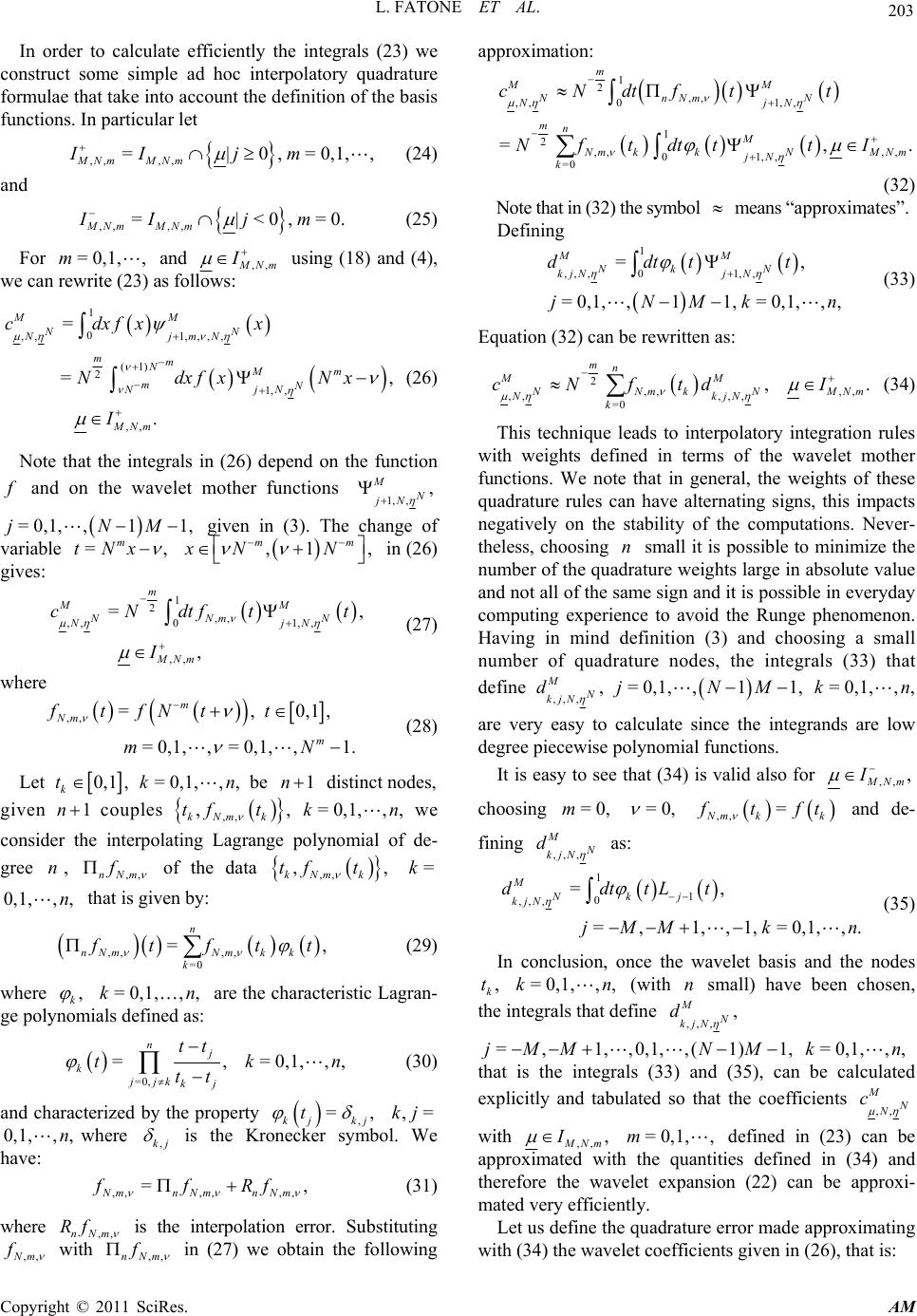 L. FATONE ET AL. Copyright © 2011 SciRes. AM 203 In order to calculate efficiently the integrals (23) we construct some simple ad hoc interpolatory quadrature formulae that take into accoun t the definition of th e basis functions. In particular let ,, ,, =|0,=0,1,, MNmMNm II jm (24) and ,, ,, =|<0,=0. MNmMNm II jm (25) For =0,1,,m and ,, M Nm I using (18) and (4), we can rewrite (23) as follows: 1 0 ,, 1,,,, (1) 21, , ,, = =, . MM NN NjmN mm NMm mN NjN MNm cdxfxx Ndxfx Nx I (26) Note that the integrals in (26) depend on the function f and on the wavelet mother functions 1,,, M N jN =0,1, ,11,jNM given in (3). The change of variable =, m tNx ,1 , mm xN N in (26) gives: 1 2,, 0 ,, 1,, ,, =, , m MM NNmN NjN MNm cNdtft t I (27) where ,, =,0,1, =0,1, ,=0,1, ,1. m Nm m ftfNtt mN (28) Let 0,1 , k t =0,1,, ,kn be 1n distinct nodes, given 1n couples ,, ,, kNm k tf t =0,1,, ,kn we consider the interpolating Lagrange polynomial of de- gree n, ,,nNm f of the data ,, ,, kNm k tf t =k 0,1,, ,n that is give n b y : ,, ,, =0 =, n nNmNmkk k f tftt (29) where , k =0,1,, ,kn are the characteristic Lagran- ge polynomials defined as: =0, =,=0,1,,, nj kjjk kj tt tkn tt (30) and characterized by the property , =, kj kj t ,=kj 0,1,, ,nwhere ,kj is the Kronecker symbol. We have: ,,,, ,, =, Nmn Nmn Nm ffRf (31) where ,,nNm Rf is the interpolation error. Substituting ,, N m f with ,,nNm f in (27) we obtain the following approximation: 1 2,, 0 ,, 1,, 1 2,, ,, 01, , =0 =,. m MM NnNmN NjN mnM N mk kNMNm jN k cNdtftt Nftdtt tI (32) Note that in (32) the symbol means “approximates”. Defining 1 0 ,, ,1,, =, = 0,1,,11,=0,1,,, MM Nk N kjNjN ddttt jNMkn (33) Equation (32) can be rewritten as: 2,, ,, ,, ,,, =0 ,. mn MM N Nm kNMNm NkjN k cNftd I (34) This technique leads to interpolatory integration rules with weights defined in terms of the wavelet mother functions. We note that in general, the weights of these quadrature rules can have alternating signs, this impacts negatively on the stability of the computations. Never- theless, choosing n small it is possible to minimize the number of the quadrature weights large in absolute value and not all of the same sign and it is possib le in everyday computing experience to avoid the Runge phenomenon. Having in mind definition (3) and choosing a small number of quadrature nodes, the integrals (33) that define ,,,, MN kjN d =0,1, ,11, j NM =0,1,, ,kn are very easy to calculate since the integrands are low degree piecewise polynomial functions. It is easy to see that (34) is valid also for ,,, M Nm I choosing =0,m =0, ,, = N mk k f tft and de- fining ,, , M N kjN d as: 1 1 0 ,, ,=, =,1, ,1,=0,1, ,. MNkj kjN ddttLt jMMk n (35) In conclusion, once the wavelet basis and the nodes , k t =0,1,,,kn (with n small) have been chosen, the integrals that define ,, ,, M N kjN d =, 1,,0,1,,(1)1,jMM NM =0,1,, ,kn that is the integrals (33) and (35), can be calculated explicitly and tabulated so that the coefficients ,, M N N c with ,,, M Nm I =0,1, ,m defined in (23) can be approximated with the quantities defined in (34) and therefore the wavelet expansion (22) can be approxi- mated very efficiently. Let us define the quadrature error made approximating with (34) the wavelet coefficients given in (26 ), that is: 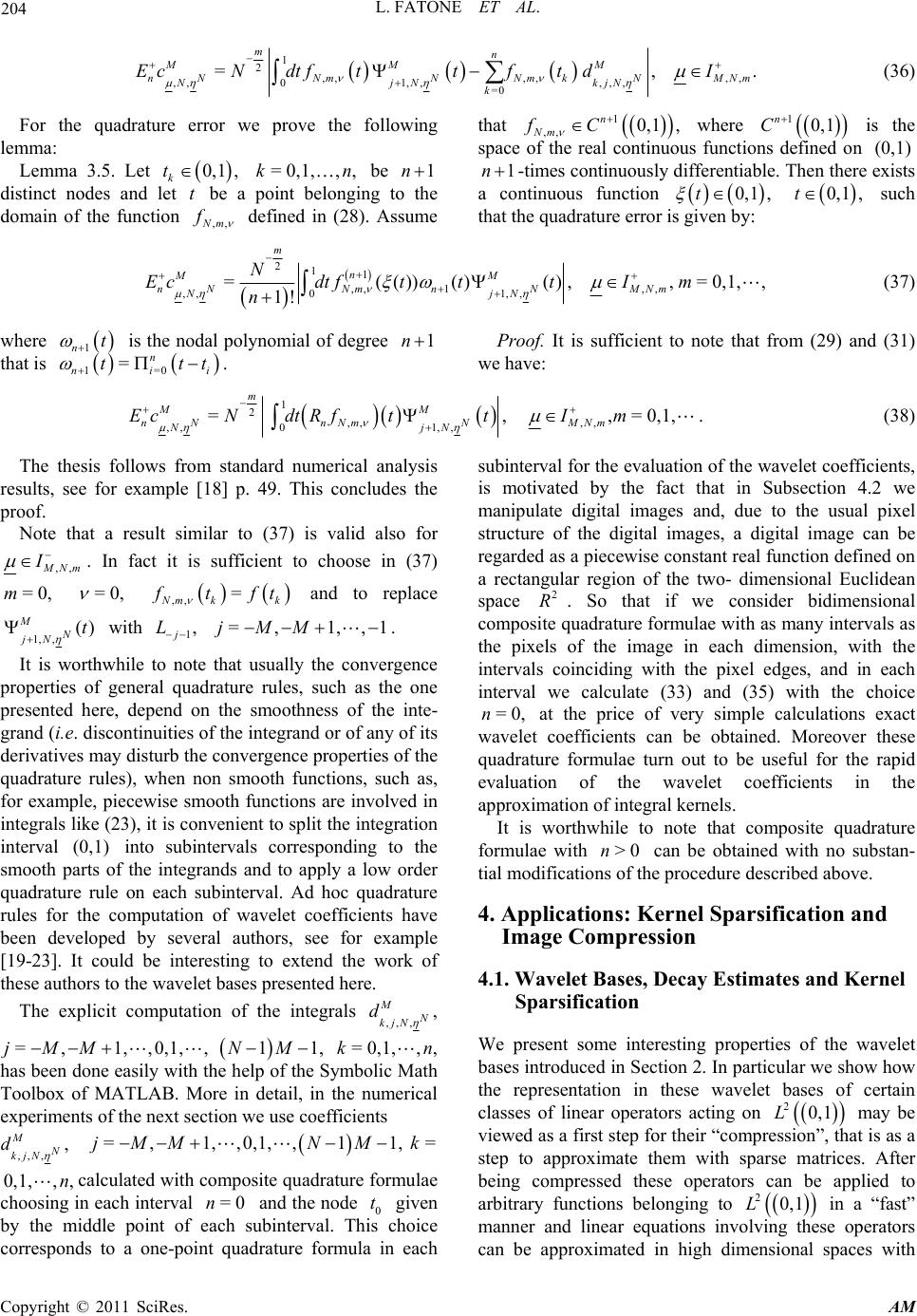 L. FATONE ET AL. Copyright © 2011 SciRes. AM 204 1 2,, ,,,, 0 ,,1,, ,,, =0 =,. mn MMM nNNmNNm kNMNm NjNkjN k EcNdtfttf tdI (36) For the quadrature error we prove the following lemma: Lemma 3.5. Let 0,1 , k t =0,1,, ,kn be 1n distinct nodes and let t be a point belonging to the domain of the function ,,Nm f defined in (28). Assume that 1 ,, 0,1 , n Nm fC where 10,1 n C is the space of the real continuous functions defined on (0,1) 1n -times continuously differentiable. Then ther e ex ists a continuous function 0,1 ,t 0,1 ,t such that the quadrature error is given by: 211 ,, 1,, 0 ,, 1,, =(())()(),,=0,1,, 1! m n MM nNNmnNMNm NjN N EcdtftttI m n (37) where 1nt is the nodal polynomial of degree 1n that is 1=0 =n nii ttt . Proof. It is sufficient to note that from (29) and (31) we have: 1 2,, ,, 0 ,, 1,, =,,=0,1, m MM nNnNmNMNm NjN EcNdtRfttI m . (38) The thesis follows from standard numerical analysis results, see for example [18] p. 49. This concludes the proof. Note that a result similar to (37) is valid also for ,, M Nm I . In fact it is sufficient to choose in (37) =0,m =0, ,, = Nm kk f tft and to replace 1, ,() MN jN t with 1, j L =, 1,,1jMM. It is worthwhile to note that usually the convergence properties of general quadrature rules, such as the one presented here, depend on the smoothness of the inte- grand (i.e. discontinuities of the integrand or of any of its derivatives may disturb the convergence properties of the quadrature rules), when non smooth functions, such as, for example, piecewise smooth functions are involved in integrals like (23), it is co nvenient to sp lit the integration interval (0,1) into subintervals corresponding to the smooth parts of the integrands and to apply a low order quadrature rule on each subinterval. Ad hoc quadrature rules for the computation of wavelet coefficients have been developed by several authors, see for example [19-23]. It could be interesting to extend the work of these authors to the wavelet bases presented here. The explicit computation of the integrals ,,,, MN kjN d =, 1,,0,1,,jMM 11,NM =0,1,, ,kn has been done easily with the help of the Symbolic Math Toolbox of MATLAB. More in detail, in the numerical experiments of the next s ect ion we use coefficients ,, ,, MN kjN d =,1,,0,1,, 11,jMM NM =k 0,1,, ,ncalculated with composite quadrature formulae choosing in each interval =0n and the node 0 t given by the middle point of each subinterval. This choice corresponds to a one-point quadrature formula in each subinterval for th e evaluation of the wavelet co efficients, is motivated by the fact that in Subsection 4.2 we manipulate digital images and, due to the usual pixel structure of the digital images, a digital image can be regarded as a piecewise constant real function defined on a rectangular region of the two- dimensional Euclidean space 2 R. So that if we consider bidimensional composite quadrature formulae with as many intervals as the pixels of the image in each dimension, with the intervals coinciding with the pixel edges, and in each interval we calculate (33) and (35) with the choice =0,n at the price of very simple calculations exact wavelet coefficients can be obtained. Moreover these quadrature formulae turn out to be useful for the rapid evaluation of the wavelet coefficients in the approximation of integral kernels. It is worthwhile to note that composite quadrature formulae with >0n can be obtained with no substan- tial modi fi cations of the procedure described above. 4. Applications: Kernel Sparsification and Image Compression 4.1. Wavelet Bases, Decay Estimates and Kernel Sparsification We present some interesting properties of the wavelet bases introduced in Section 2. In particular we show how the representation in these wavelet bases of certain classes of linear operators acting on 20,1L may be viewed as a first step for their “compression”, that is as a step to approximate them with sparse matrices. After being compressed these operators can be applied to arbitrary functions belonging to 20,1L in a “fast” manner and linear equations involving these operators can be approximated in high dimensional spaces with 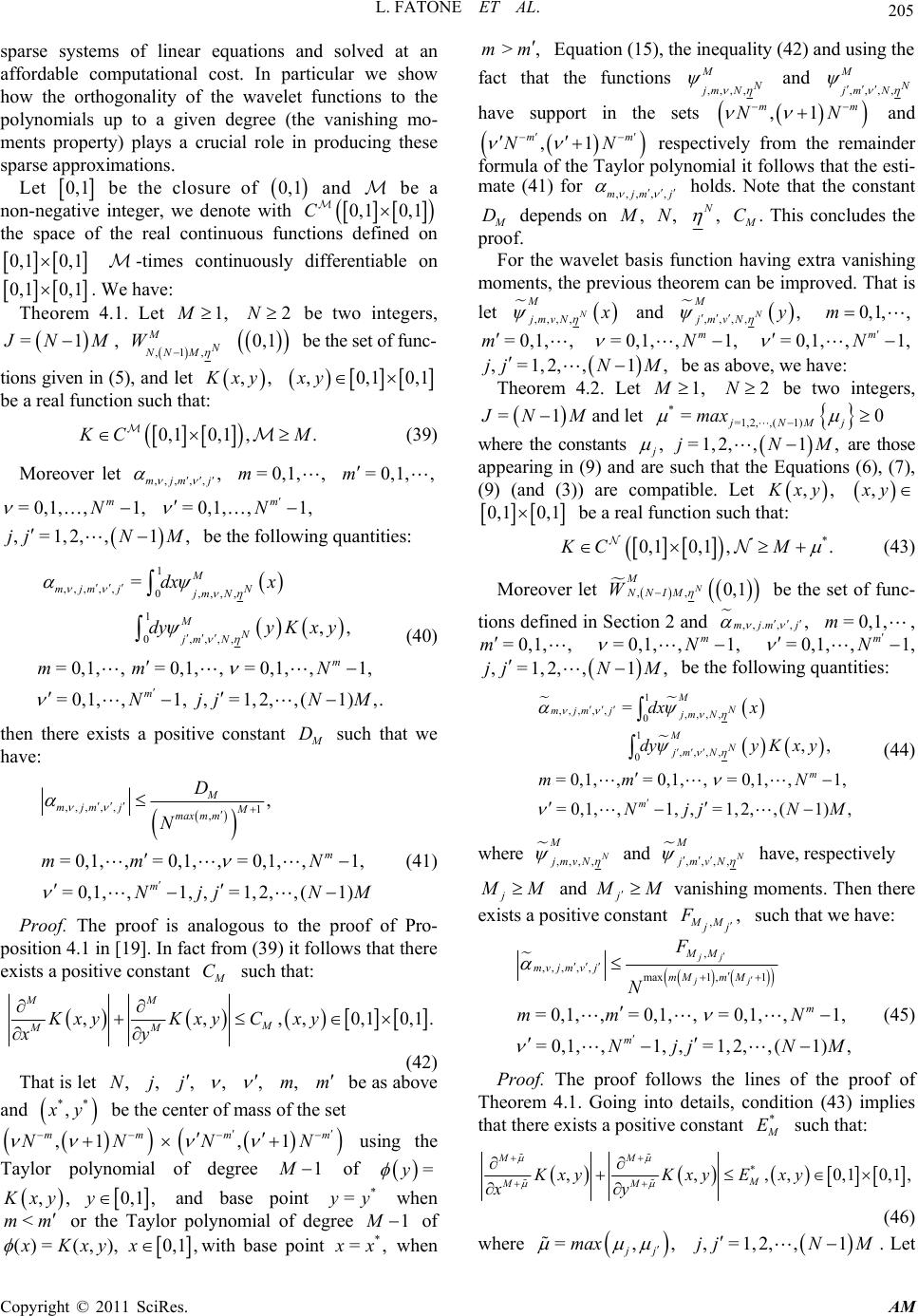 L. FATONE ET AL. Copyright © 2011 SciRes. AM 205 sparse systems of linear equations and solved at an affordable computational cost. In particular we show how the orthogonality of the wavelet functions to the polynomials up to a given degree (the vanishing mo- ments property) plays a crucial role in producing these sparse approx imations. Let 0,1 be the closure of 0,1 and be a non-negative integer, we denote with 0,1 0,1C the space of the real continuous functions defined on 0,1 0,1 -times continuously differentiable on 0,1 0,1. We ha ve: Theorem 4.1. Let 1,M 2N be two integers, =1 J NM, ,1, M N NNM W 0,1 be the set of func- tions given in (5), and let ,, K xy ,0,10,1xy be a real function such that: 0,10,1 ,. K CM (39) Moreover let ,,,, ,, mjm j =0,1, ,m =0,1, ,m =0,1, ,1, m N =0,1,,1, m N ,=1,2, ,1,jjN M be the following quantities: 1 ,,,, ,0,,,, 1 0,,,, = ,, =0,1, ,=0,1, ,=0,1, ,1, =0,1, ,1,, =1,2, ,(1),. M mjm jN jm N MN jmN m m dx x dyyKxy mm N Njj NM (40) then there exists a positive constant M D such that we have: ,,,, ,1 ,, =0,1, ,=0,1, ,=0,1, ,1, =0,1, ,1,,=1,2, ,(1) M mjm jM maxm m m m D N mmN NjjNM (41) Proof. The proof is analogous to the proof of Pro- position 4.1 in [19]. In fact from (39) it follows that there exists a positive constant M C such that: ,,,,0,10,1. MM M MM KxyKxyCxy xy (42) That is let ,N ,j ,j , , ,m m be as above and ** , x y be the center of mass of the set ,1,1 mmm m NNN N using the Taylor polynomial of degree 1 M of = y ,, K xy 0,1 ,y and base point * = y y when <mm or the Taylor polynomial of degree 1 M of ()= (,),0,1,xKxyx with base point * =, x x when >,mm Equation (15), the inequality (42) an d using the fact that the functions ,,,, M N jm N and ,,,, M N jm N have support in the sets ,1 mm NN and ,1 mm NN respectively from the remainder formula of the Taylor po lynomial it follows that the esti- mate (41) for ,,,, ,mjm j holds. Note that the constant M D depends on , M ,N , N M C. This concludes the proof. For the wavelet basis function having extra vanishing moments, the previous theorem can be improved. That is let ,,,,N M jmvN x and ,,,,, N M jmvN y 0,1,,m =0,1, ,m =0,1, ,1, m N =0,1,,1, m N ,=1,2, ,1,jjNM be as above, we have: Theorem 4.2. Let 1,M 2N be two integers, =1 J NMand let *=1,2, ,(1) =0 jNMj max where the constants , j =1,2, ,1,jNM are those appearing in (9) and are such that the Equations (6), (7), (9) (and (3)) are compatible. Let ,, K xy , x y 0,1 0,1 be a real function such that: * 0,10,1 ,.KC M (43) Moreover let ,, 0, 1 N M NNIM W be the set of func- tions defined in Section 2 and ,,., ,, mjmj =0,1,m, =0,1, ,m =0,1,,1, m N =0,1,,1, m N ,=1,2, ,1,jjN M be the following quantities: 1 ,,,, ,,,,, 0 1 ,,,, 0 = ,, =0,1,,=0,1, ,=0,1,,1, =0,1, ,1,,=1,2, ,(1), MN mjmjjm N MN jm N m m dx x dyyKx y mm N Njj NM (44) where ,,,,N M jmvN and ,,,, N M jmvN have, respectively j M M and j M M vanishing moments. Then there exists a positive constant ,, MM j j F such that we have: , ,,,,,max1,1 =0,1, ,=0,1, ,=0,1, ,1, =0,1, ,1,,=1,2, ,(1), jj jj MM mv jmvjmMm M m m F N mm N Njj NM (45) Proof. The proof follows the lines of the proof of Theorem 4.1. Going into details, condition (43) implies that there exists a positive con stant * M E such that: * ,,,,0,10,1, MM M MM KxyKxyE xy xy (46) where =,, jj max ,=1,2, ,1jjN M . Let  L. FATONE ET AL. Copyright © 2011 SciRes. AM 206 ,N ,j ,j , , ,m m be as above and ** , x y be the center of mass of the set ,1 mm NN ,1 mm NN . Initially let us consider the case < j j M M.When mm (and therefore 1 j mM 1 j mM ) we can use the Taylor polynomial of =,, y Kxy 0,1 ,y of degree 1 j M and base point * = y y. Because of Equation (17) and assumption (46) mimicking the proof of Theorem 4.1, we can obtain the estimate (45) for ,,,, ,mjm j with N raised to the power (1) j mM in the denominator. On the other hand if >mm when (1) j mM <( 1) j mM it is convenient to proceed as done previously, when (1)(1) jj mMmM it is better to use the Taylor polynomial of degree 1 j M of =,, x Kxy 0,1 ,x with base point * = x x obtaining with a simi- lar procedure the estimate (45) for ,,,, ,mjm j with N raised to the power 1 j mM in the deno minator. The other estimates contained in (45) for ,,,, ,mjm j when > j j M M or = j j M M can be obtained in a similar way. Note that the constant,MM j j F depends on , j M , j M ,N , N η * M E. This concludes the proof. The estimates (41) and (45) are the basic properties that together with a simple truncation procedure make the wavelet bases introduced previously useful to appro- ximate with sparse matrices linear operators. Let be an integral operator acting on 20,1L of the form: 12 0 =,,0,1 ,0,1,fx dyKxyfyxfL (47) where the kernel K is a real function of two variables. The compression algorithms we are interested in are base d on the following observation. Generalizing what done in Section 2 for a function 20,1fL, when is represented on a wavelet basis, i.e. when the kernel K is expanded as a function of two variables on the wavelet basis (20), the calculation of the entries of the (infinite) matrix that represents the operator in the wavelet basis involves the evaluation of the integrals (40) or (44). If the wavelet basis considered has several vanishing mo- ments and we look at truncated wavelet expansions, that is to an expansion on a truncated wavelet basis, when the kernel K is sufficiently regular, thanks to the estimates (41) or (45), the fraction of the entries whose absolute value is smaller than a chosen threshold approaches one when the truncated expansion approaches the true expan- sion. The entries whose absolute value is smaller than a suitable threshold can be set to zero committing a “sma ll” error. This property makes possible the approximation of the integral operator (47) with sparse matrices and makes possible to solve numerically integral equations very efficiently. Note that when two different wavelet bases with the same number of vanishing moments are used to represent the operator the estimates (41) and (45) show that the wavelets with the smaller between the constants M D or ,MM j j F will have expansion coefficients that decay faster to zero. Similar arguments can be made in the discrete case, where we consider a piecewise constant function defined on a bounded rect ang ul ar d o main of the form: ,, ,= ,,, ,=1,2 ,,,0,10,1, ij ij xyxyA ijr xy (48) where r is a positive integer and >0h is such that =1hr and where ,ij A is the “pixel” of indices ,,ij i.e. ,=, 0,10,1|=,=, ij xy A xyint iintj hh ,=1,2 ,.ij r Note that ()int denotes the integer part of . Some applications of these estimates to specific exam- ples are shown below. We use the Wavelet Bases 1, 2, 3, 4 of the Appendix to test the performances of the integr al operators compression algorithm described previously. We apply the algorithm to a number of operators. The direct and inverse wavelet transforms used in the numeri- cal experience associated to these wavelet bases have been implemented in FORTRAN 90. Briefly we remind that the Wavelet Bases 1 and 3 of th e Appendix are done with piecewise polynomial functions made of polynomials of degree zero, while the Wavelet Bases 2 and 4 of the Appendix are done with piecewise polynomial functions made of polynomials of degree one. Moreover the Wave- let Bases 1 and 2 are obtained using the regularity cri- terion (i.e. criterion 1)), while the Wavelet Bases 3 and 4 are obtained using the “extra vanishing moments” cri- terion (i.e. criterion 2)). The choice of reporting here and in Subsection 4.2 the numerical results obtained with the Wavelet Bases 1, 2, 3, 4 of the Appendix is motivated by the fact that these are the simplest bases among the bases introduced in Section 2 that it is possible to construct and manipulate. Mo- reover the Bases 1 and 3 made of piecewise constant functions are particularly well suited to deal with piece- wise constant functions. This type of functions is very important since it can be identified with digital signals 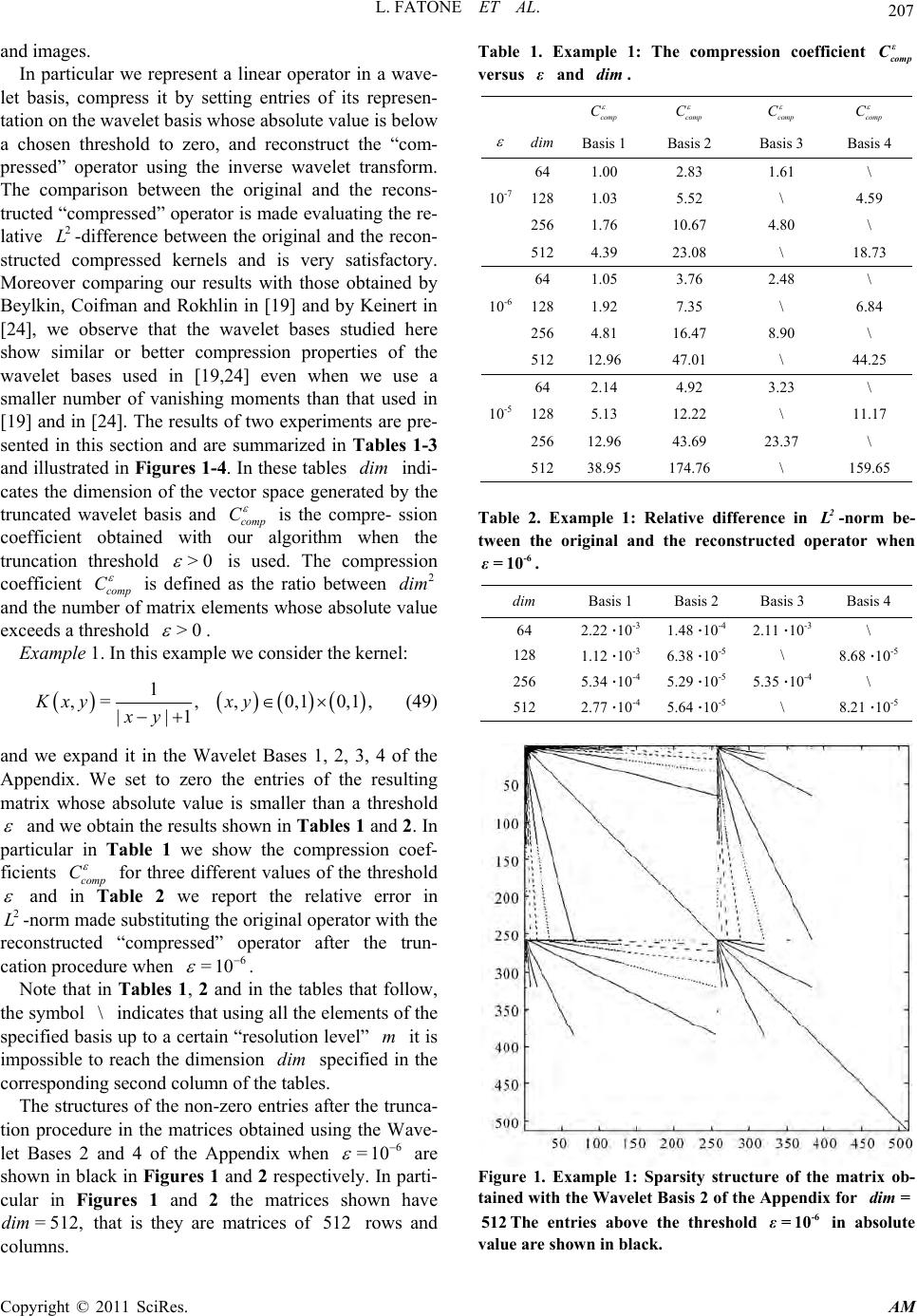 L. FATONE ET AL. Copyright © 2011 SciRes. AM 207 and images. In particular we represent a linear operator in a wave- let basis, compress it by setting entries of its represen- tation on the wav elet basis whose absolute value is be low a chosen threshold to zero, and reconstruct the “com- pressed” operator using the inverse wavelet transform. The comparison between the original and the recons- tructed “compressed” operator is made evaluating the re- lative 2 L-difference between the original and the recon- structed compressed kernels and is very satisfactory. Moreover comparing our results with those obtained by Beylkin, Coifman and Rokhlin in [19] and by Keinert in [24], we observe that the wavelet bases studied here show similar or better compression properties of the wavelet bases used in [19,24] even when we use a smaller number of vanishing moments than that used in [19] and in [24]. The results of two experiments are pre- sented in this section and are summarized in Tables 1-3 and illustrated in Figures 1-4. In these tables dim indi- cates the dimension of the vector space generated by the truncated wavelet basis and comp C is the compre- ssion coefficient obtained with our algorithm when the truncation threshold >0 is used. The compression coefficient comp C is defined as the ratio between 2 dim and the number of matrix elements whose ab solute value exceeds a threshold >0 . Example 1. In this example we consider the kernel: 1 ,=,,0,10,1, ||1 Kxyxy xy (49) and we expand it in the Wavelet Bases 1, 2, 3, 4 of the Appendix. We set to zero the entries of the resulting matrix whose absolute value is smaller than a threshold and we obtain the results shown in Tab le s 1 and 2. In particular in Table 1 we show the compression coef- ficients comp C for three different values of the threshold and in Table 2 we report the relative error in 2 L-norm made substituting the original operator with the reconstructed “compressed” operator after the trun- cation proce dure when 6 =10 . Note that in Tables 1, 2 and in the tables that follow, the symbol \ indicates that using all the elements of the specified basis up to a certain “resolution level” m it is impossible to reach the dimension dim specified in the corresponding second column of the tables. The structures of the non-zero entries after the trunca- tion procedure in the matrices obtained using the Wave- let Bases 2 and 4 of the Appendix when 6 =10 are shown in black in Figures 1 and 2 respectively. In parti- cular in Figures 1 and 2 the matrices shown have =512,dim that is they are matrices of 512 rows and columns. Table 1. Example 1: The compression coefficient ε comp C versus ε and dim . comp C comp C comp C comp C dim Basis 1 Basis 2 Basis 3 Basis 4 64 1.00 2.83 1.61 \ 10-7 1281.03 5.52 \ 4.59 2561.76 10.67 4.80 \ 5124.39 23.08 \ 18.73 64 1.05 3.76 2.48 \ 10-6 1281.92 7.35 \ 6.84 2564.81 16.47 8.90 \ 51212.96 47.01 \ 44.25 64 2.14 4.92 3.23 \ 10-5 1285.13 12.22 \ 11.17 25612.96 43.69 23.37 \ 51238.95 174.76 \ 159.65 Table 2. Example 1: Relative difference in 2 L-norm be- tween the original and the reconstructed operator when -6 =10ε. dim Basis 1 Basis 2 Basis 3 Basis 4 64 2.22・10-3 1.48・10-4 2.11・10-3 \ 128 1.12・10-3 6.38・10-5 \ 8.68・10-5 256 5.34・10-4 5.29・10-5 5.35・10-4 \ 512 2.77・10-4 5.64・10-5 \ 8.21・10-5 Figure 1. Example 1: Sparsity structure of the matrix ob- tained with the Wavelet Basis 2 of the Appendix for dim = 512The entries above the threshold -6 =10ε in absolute value are shown in black. 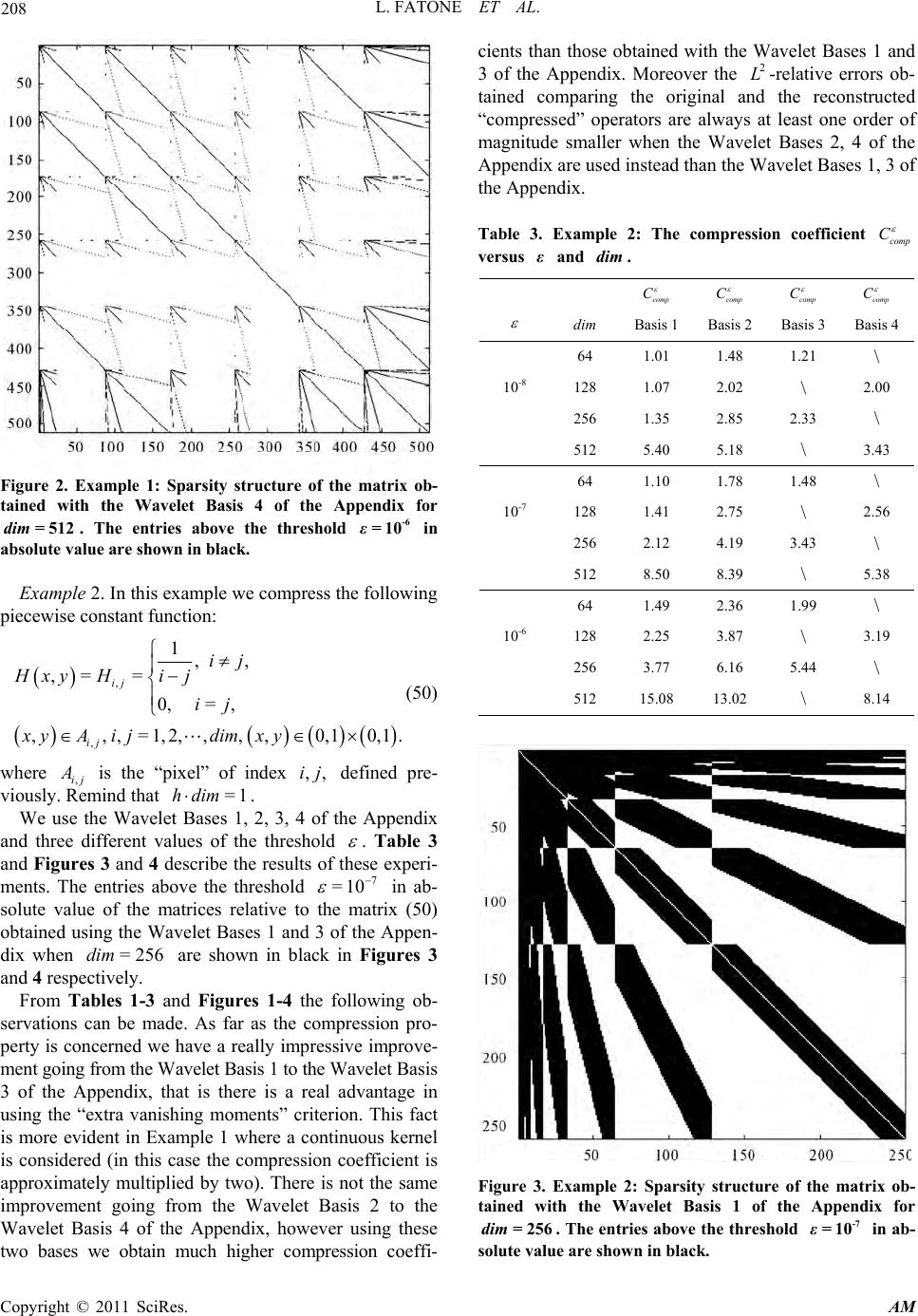 L. FATONE ET AL. Copyright © 2011 SciRes. AM 208 Figure 2. Example 1: Sparsity structure of the matrix ob- tained with the Wavelet Basis 4 of the Appendix for 512dim =. The entries above the threshold -6 =10ε in absolute value are shown in black. Example 2. In this example we compress the following piecewise constant function: , , 1,, ,== 0,= , ,,,=1,2,,,,0,10,1 . ij ij ij ij Hxy H ij xyAijdim xy (50) where ,ij A is the “pixel” of index ,,ij defined pre- viously. Remind that =1hdim. We use the Wavelet Bases 1, 2, 3, 4 of the Appendix and three different values of the threshold . Table 3 and Figures 3 and 4 describe the results of these experi- ments. The entries above the threshold 7 =10 in ab- solute value of the matrices relative to the matrix (50) obtained using the Wavelet Bases 1 and 3 of the Appen- dix when = 256dim are shown in black in Figures 3 and 4 respectively. From Tables 1-3 and Figures 1-4 the following ob- servations can be made. As far as the compression pro- perty is concerned we have a really impressive improve- ment going from the Wave let Basis 1 to the Wavelet Basis 3 of the Appendix, that is there is a real advantage in using the “extra vanishing moments” criterion. This fact is more evident in Example 1 where a continuous kernel is considered (in this case the compression coefficient is approximately multiplied by two). There is not the same improvement going from the Wavelet Basis 2 to the Wavelet Basis 4 of the Appendix, however using these two bases we obtain much higher compression coeffi- cients than those obtained with the Wavelet Bases 1 and 3 of the Appendix. Moreover the 2 L-relative errors ob- tained comparing the original and the reconstructed “compressed” operators are always at least one order of magnitude smaller when the Wavelet Bases 2, 4 of the Appendix are used instead than the Wavelet Bases 1, 3 of the Appendix. Table 3. Example 2: The compression coefficient comp C versus ε and dim . comp C comp C comp C comp C dim Basis 1Basis 2 Basis 3 Basis 4 64 1.01 1.48 1.21 \ 10-8 128 1.07 2.02 \ 2.00 256 1.35 2.85 2.33 \ 512 5.40 5.18 \ 3.43 64 1.10 1.78 1.48 \ 10-7 128 1.41 2.75 \ 2.56 256 2.12 4.19 3.43 \ 512 8.50 8.39 \ 5.38 64 1.49 2.36 1.99 \ 10-6 128 2.25 3.87 \ 3.19 256 3.77 6.16 5.44 \ 512 15.08 13.02 \ 8.14 Figure 3. Example 2: Sparsity structure of the matrix ob- tained with the Wavelet Basis 1 of the Appendix for 256dim =. The entries above the threshold -7 =10ε in ab- solute value are shown in black. 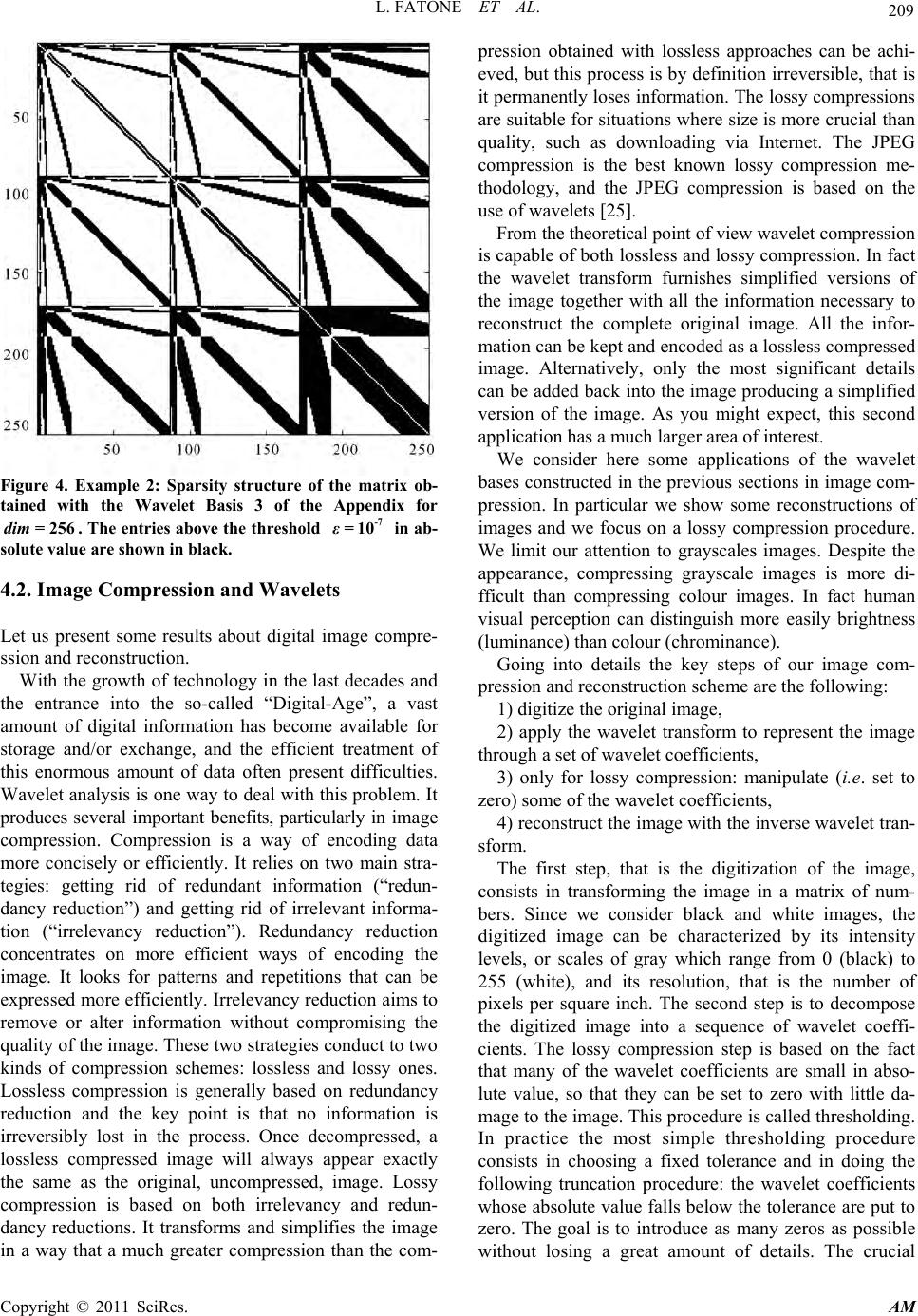 L. FATONE ET AL. Copyright © 2011 SciRes. AM 209 Figure 4. Example 2: Sparsity structure of the matrix ob- tained with the Wavelet Basis 3 of the Appendix for 256dim=. The entries above the threshold -7 =10ε in ab- solute value are shown in black. 4.2. Image Compression and Wavelets Let us present some results about digital image compre- ssion and reconstruction. With the growth of technology in the last decades and the entrance into the so-called “Digital-Age”, a vast amount of digital information has become available for storage and/or exchange, and the efficient treatment of this enormous amount of data often present difficulties. Wavelet analysis is one way to d eal with this problem. It produces several important benefits, particularly in image compression. Compression is a way of encoding data more concisely or efficiently. It relies on two main stra- tegies: getting rid of redundant information (“redun- dancy reduction”) and getting rid of irrelevant informa- tion (“irrelevancy reduction”). Redundancy reduction concentrates on more efficient ways of encoding the image. It looks for patterns and repetitions that can be expressed more efficiently. Irrelevancy reduction aims to remove or alter information without compromising the quality of the image. These two strategies condu ct to two kinds of compression schemes: lossless and lossy ones. Lossless compression is generally based on redundancy reduction and the key point is that no information is irreversibly lost in the process. Once decompressed, a lossless compressed image will always appear exactly the same as the original, uncompressed, image. Lossy compression is based on both irrelevancy and redun- dancy reductions. It transforms and simplifies the image in a way that a much greater compression than the com- pression obtained with lossless approaches can be achi- eved, but this process is by definition irreversible, th at is it permanently loses informatio n. The lossy compressions are suitable for situations where size is more crucial th an quality, such as downloading via Internet. The JPEG compression is the best known lossy compression me- thodology, and the JPEG compression is based on the use of wavelets [25]. From the theoret ical po int of v iew wavelet c o mpr e s s i o n is capable of both lossless and lossy compression. In fact the wavelet transform furnishes simplified versions of the image together with all the information necessary to reconstruct the complete original image. All the infor- mation can be kept and encoded as a lossless compressed image. Alternatively, only the most significant details can be added back into the image producing a simplified version of the image. As you might expect, this second application has a much larger area of interest. We consider here some applications of the wavelet bases constructed in the previous sections in image com- pression. In particular we show some reconstructions of images and we focus on a lossy compression procedure. We limit our attention to grayscales images. Despite the appearance, compressing grayscale images is more di- fficult than compressing colour images. In fact human visual perception can distinguish more easily brightness (luminance) than colour (chrominance). Going into details the key steps of our image com- pression and reconstruction scheme are the following: 1) digitize the original image, 2) apply the wavelet transform to represent the image through a set of wavelet coefficien ts, 3) only for lossy compression: manipulate (i.e. set to zero) some of the wavelet coefficients, 4) reconstruct the image with the inv erse wavelet tran- sform. The first step, that is the digitization of the image, consists in transforming the image in a matrix of num- bers. Since we consider black and white images, the digitized image can be characterized by its intensity levels, or scales of gray which range from 0 (black) to 255 (white), and its resolution, that is the number of pixels per square inch. The second step is to decompose the digitized image into a sequence of wavelet coeffi- cients. The lossy compression step is based on the fact that many of the wavelet coefficients are small in abso- lute value, so that they can be set to zero with little da- mage to the image. This procedure is called thresho lding. In practice the most simple thresholding procedure consists in choosing a fixed tolerance and in doing the following truncation procedure: the wavelet coefficients whose absolute value falls belo w the tolerance are put to zero. The goal is to introduce as many zeros as possible without losing a great amount of details. The crucial 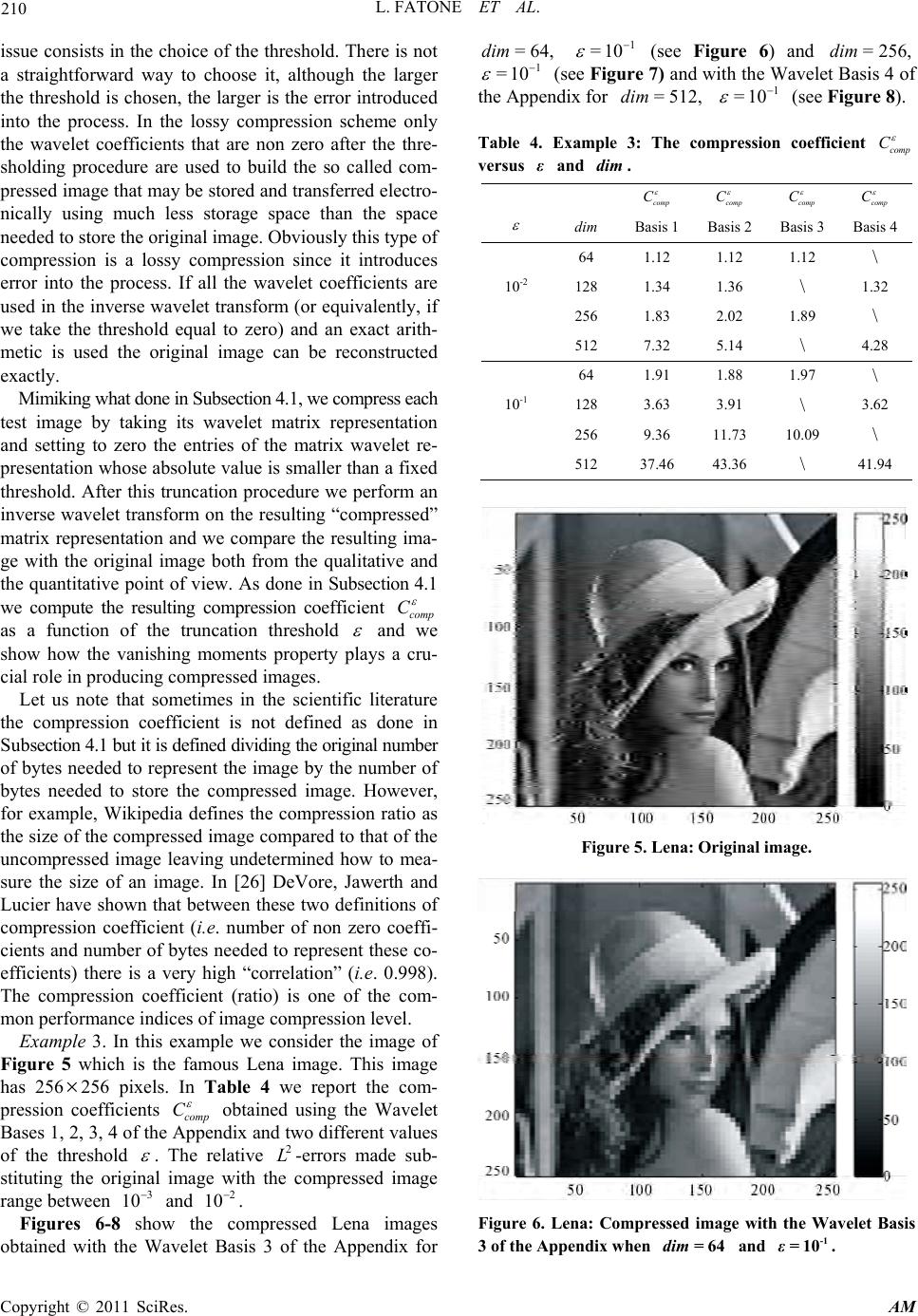 L. FATONE ET AL. Copyright © 2011 SciRes. AM 210 issue consists in the choice of the threshold. There is no t a straightforward way to choose it, although the larger the threshold is chosen, the larger is the error introduced into the process. In the lossy compression scheme only the wavelet coefficients that are non zero after the thre- sholding procedure are used to build the so called com- pressed image that may be stored and transferred electro- nically using much less storage space than the space needed to store the original image. Obviously th is type of compression is a lossy compression since it introduces error into the process. If all the wavelet coefficients are used in the inverse wav elet transform (or equivalently, if we take the threshold equal to zero) and an exact arith- metic is used the original image can be reconstructed exactly. Mimiking what done in Subsection 4.1, we com press each test image by taking its wavelet matrix representation and setting to zero the entries of the matrix wavelet re- presentation whose absolute value is smaller than a fixed threshold. After this truncation procedure we perform an inverse wavelet transform on the resulting “compressed” matrix representation and we compare the resulting ima- ge with the original image both from the qualitative and the quantitative point of view. As done in Subsection 4.1 we compute the resulting compression coefficient comp C as a function of the truncation threshold and we show how the vanishing moments property plays a cru- cial role in producing compressed images. Let us note that sometimes in the scientific literature the compression coefficient is not defined as done in S u bsection 4.1 but it is defined d ividing the original number of bytes needed to represent the image by the number of bytes needed to store the compressed image. However, for example, Wikipedia defines the compression ratio as the size of the compressed image compared to that of the uncompressed image leaving undetermined how to mea- sure the size of an image. In [26] DeVore, Jawerth and Lucier have shown that between these two definitions of compression coefficient (i.e. number of non zero coeffi- cients and number of bytes needed to represent these co- efficients) there is a very high “correlation” (i.e. 0.998). The compression coefficient (ratio) is one of the com- mon performance indices of image compression level. Example 3. In this example we consider the image of Figure 5 which is the famous Lena image. This image has 256256 pixels. In Table 4 we report the com- pression coefficients comp C obtained using the Wavelet Bases 1, 2, 3, 4 of the Appendix and two different values of the threshold . The relative 2 L-errors made sub- stituting the original image with the compressed image range between 3 10 and 2 10. Figures 6-8 show the compressed Lena images obtained with the Wavelet Basis 3 of the Appendix for =64,dim 1 =10 (see Figure 6) and = 256,dim 1 =10 (see Figure 7) and with the Wavelet Basis 4 of the Appendix fo r =512,dim 1 =10 (see Figure 8). Table 4. Example 3: The compression coefficient comp C versus ε and dim . comp C comp C comp C comp C dim Basis 1Basis 2 Basis 3 Basis 4 64 1.12 1.12 1.12 \ 10-2 128 1.34 1.36 \ 1.32 256 1.83 2.02 1.89 \ 512 7.32 5.14 \ 4.28 64 1.91 1.88 1.97 \ 10-1 128 3.63 3.91 \ 3.62 256 9.36 11.73 10.09 \ 512 37.46 43.36 \ 41.94 Figure 5. Lena: Original image . Figure 6. Lena: Compressed image with the Wavelet Basis 3 of the Appendix when 64dim= and -1 =10ε.  L. FATONE ET AL. Copyright © 2011 SciRes. AM 211 Figure 7. Lena: Compressed image with the Wavelet Basis 3 of the Appendix when 256dim = and -1 =10ε. Figure 8. Lena: Compressed image with the Wavelet Basis 4 of the Appendix when 512dim = and -1 =10ε. Example 4. We consider the image of Figure 9. In this image are evident three different types of objects: a shape (the black star), a number (‘2025’) and an inscri- ption (‘black’). This image has 278268 pixels. Table 5 shows the compression coefficients comp C obtained using the Wavelet Bases 1, 2, 3, 4 of the Appendix and two different values of the threshold . The relative 2 L-errors made substituting the original image with the compressed image range between 3 10 and 2 10 . Figures 10-12 show the compressed images of Figure 9 obtained for =128,dim 1 =510 and the Wavelet Bases 1, 2, 4 of the Appendix respectively. Figures 13-15 show the compressed images of Figure 9 obtained for = 256,dim 1 =10 and the Wavelet Bases 1, 2, 3 of the Appendix respectively. The comparisons between Tables 4-5 and Figures 5-15 suggest the following observations and comments. With respect to the compression property there is a different behaviour of the Wavelet Bases 1, 2, 3, 4 of the Appendix between operator compression and image Table 5. Example 4: The compression coefficient ε comp C versus ε and dim . comp C comp C comp C comp C dim Basis 1Basis 2 Basis 3Basis 4 64 2.42 2.30 2.48 \ 10-1 128 4.55 4.75 \ 4.23 256 11.73 13.29 12.67 \ 512 38.53 46.56 \ 42.50 64 4.77 5.23 5.09 \ 5 10-1 128 14.14 15.18 \ 14.38 256 52.68 56.69 53.63 \ 512 208.05 226.38 \ 217.73 Figure 9. Example 4: Original image. Figure 10. Example 4: Compressed image with the Wavelet Basis 1 of the Appendix when 128 dim = and -1 =5 10ε.  L. FATONE ET AL. Copyright © 2011 SciRes. AM 212 Figure 11. Example 4: Compressed image with the Wavelet Basis 2 of the Appendix when 128 dim = and -1 =5 10ε. Figure 12. Example 4: Compressed image with the Wavelet Basis 4 of the Appendix when 128 dim = and -1 =5 10ε. Figure 13. Example 4: Compressed image with the Wavelet Basis 1 of the Appendix when 256 dim = and -1 =10ε. Figure 14. Example 4: Compressed image with the Wavelet Basis 2 of the Appendix when 256 dim = and -1 =10ε. Figure 15. Example 4: Compressed image with the Wavelet Basis 3 of the Appendix when 256 dim = and -1 =10ε. compression. In fact in this last case the use of the Wave- let Bases 1 and 3 (made of piecewise polynomial func- tions made of polynomials of degree zero and obtained with the two different criteria proposed in Section 2) and the use of Wavelet Bases 2 and 4 (made of piecewise polynomial functions made of polynomials of degree one and obtained with the two different criteria proposed in Section 2) furnish similar compression coefficients. This is not really surprising since the images have a natural discontinuity structure given by the pixels. Nevertheless the compression coefficients obtained with the Wavelet Basis 3 are always higher than those obtained using the Wavelet Basis 1 and the Wavelet Bases 2 and 4 give compression coefficients higher than those obtained with the Wavelet Bases 1 and 3. Furthermore the use of the Wavelet Bases 2 and 4 seems to have a regularizing effe- ct on the images, that is the images reconstructed with these two bases appear to have a smaller number of 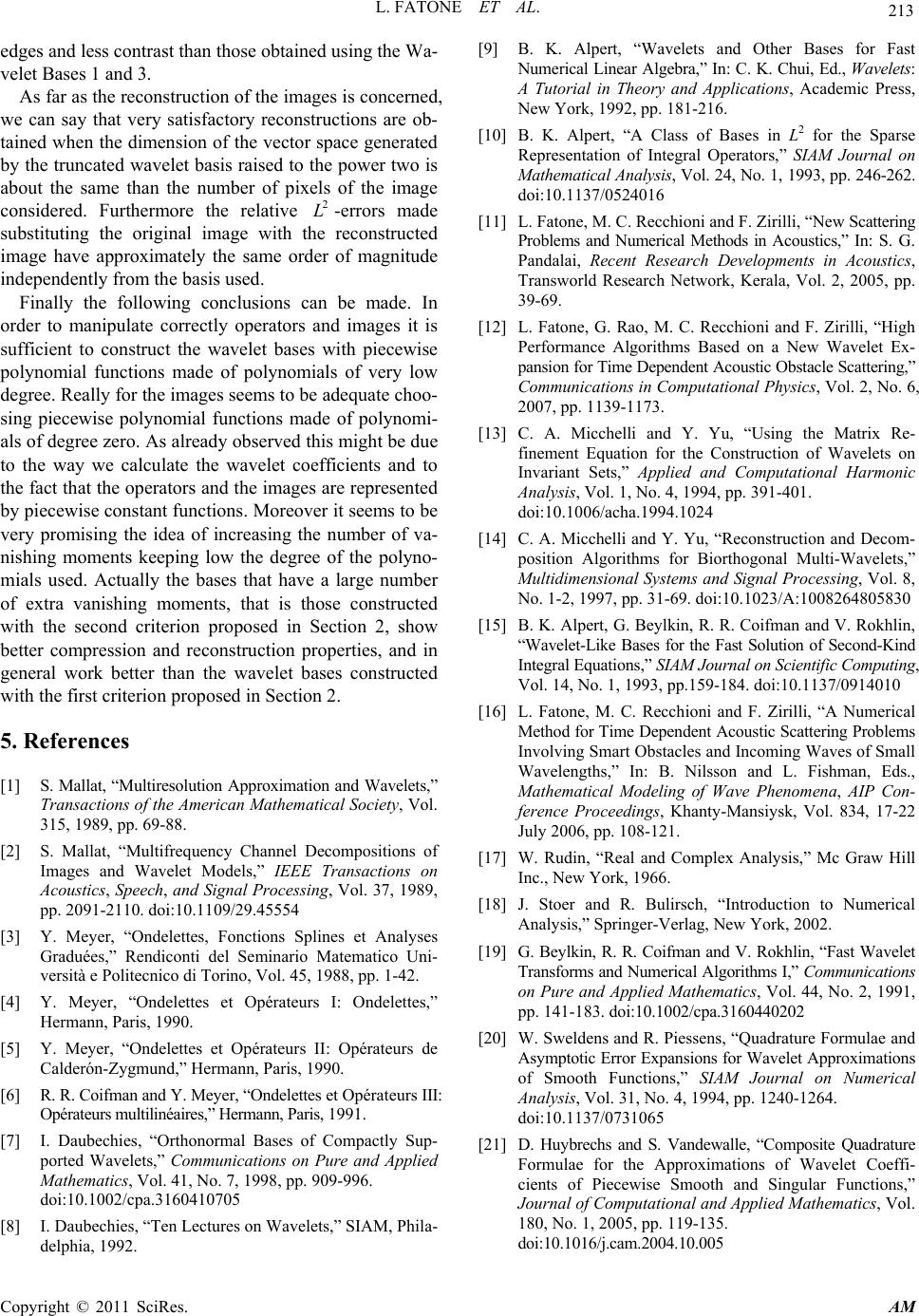 L. FATONE ET AL. Copyright © 2011 SciRes. AM 213 edges and less contrast than those obtained using the Wa- velet Bases 1 and 3. As far as the reconstruction of the images is concerned, we can say that very satisfactory reconstructions are ob- tained when the dimension of the vector space generated by the truncated wave let basis raised to the power two is about the same than the number of pixels of the image considered. Furthermore the relative 2 L-errors made substituting the original image with the reconstructed image have approximately the same order of magnitude independently from the basis used. Finally the following conclusions can be made. In order to manipulate correctly operators and images it is sufficient to construct the wavelet bases with piecewise polynomial functions made of polynomials of very low degree. Really for the images seems to be adequate choo- sing piecewise polynomial functions made of polynomi- als of degree zero. As already observed this might be due to the way we calculate the wavelet coefficients and to the fact that the operators and the images are represented by piecewise constant functions. Moreover it seems to be very promising the idea of increasing the number of va- nishing moments keeping low the degree of the polyno- mials used. Actually the bases that have a large number of extra vanishing moments, that is those constructed with the second criterion proposed in Section 2, show better compression and reconstruction properties, and in general work better than the wavelet bases constructed with the first criterion proposed in Section 2. 5. References [1] S. Mallat, “Multiresolution Approximation and Wavelets,” Transactions of the American Mathematical Society, Vol. 315, 1989, pp. 69-88. [2] S. Mallat, “Multifrequency Channel Decompositions of Images and Wavelet Models,” IEEE Transactions on Acoustics, Speech, and Signal Processing, Vol. 37, 1989, pp. 2091-2110. doi:10.1109/29.45554 [3] Y. Meyer, “Ondelettes, Fonctions Splines et Analyses Graduées,” Rendiconti del Seminario Matematico Uni- versità e Politecnico di Torino, Vol. 45, 1988, pp. 1-42. [4] Y. Meyer, “Ondelettes et Opérateurs I: Ondelettes,” Hermann, Paris, 1990. [5] Y. Meyer, “Ondelettes et Opérateurs II: Opérateurs de Calderón-Zygmund,” Hermann, Paris, 1990. [6] R. R. Coifman and Y. Meyer, “Ondelettes et Opérateurs III: Opérateurs multilinéaires,” Hermann, Paris, 1991. [7] I. Daubechies, “Orthonormal Bases of Compactly Sup- ported Wavelets,” Communications on Pure and Applied Mathematics, Vol. 41, No. 7, 1998, pp. 909-996. doi:10.1002/cpa.3160410705 [8] I. Daubechies, “Ten Lectures on Wavelets,” SIAM, Phila- delphia, 1992. [9] B. K. Alpert, “Wavelets and Other Bases for Fast Numerical Linear Algebra,” In: C. K. Chui, Ed., Wavelets: A Tutorial in Theory and Applications, Academic Press, New York, 1992, pp. 181-216. [10] B. K. Alpert, “A Class of Bases in L2 for the Sparse Representation of Integral Operators,” SIAM Journal on Mathematical Analysis, Vol. 24, No. 1, 1993, pp. 246-262. doi:10.1137/0524016 [11] L. Fatone, M. C. Recchioni and F. Zirilli, “New Scattering Problems and Numerical Methods in Acoustics,” In: S. G. Pandalai, Recent Research Developments in Acoustics, Transworld Research Network, Kerala, Vol. 2, 2005, pp. 39-69. [12] L. Fatone, G. Rao, M. C. Recchioni and F. Zirilli, “High Performance Algorithms Based on a New Wavelet Ex- pansion for Time Depende nt Acou stic Obst acle Sca ttering,” Communications in Computational Physics, Vol. 2, No. 6, 2007, pp. 1139-1173. [13] C. A. Micchelli and Y. Yu, “Using the Matrix Re- finement Equation for the Construction of Wavelets on Invariant Sets,” Applied and Computational Harmonic Analysis, Vol. 1, No. 4, 1994, pp. 391-401. doi:10.1006/acha.1994.1024 [14] C. A. Micchelli and Y. Yu, “Reconstruction and Decom- position Algorithms for Biorthogonal Multi-Wavelets,” Multidimensional Systems and Signal Processing, Vol. 8, No. 1-2, 1997, pp. 31-69. doi:10.1023/A:1008264805830 [15] B. K. Alpert, G. Beylkin, R. R. Coifman and V. Rokhlin, “Wavelet-Like Bases for the Fast Solution of Second-Kind Integral Equations,” SIAM Journal on Scientific Computing, Vol. 14, No. 1, 1993, pp.159-184. doi:10.1137/0914010 [16] L. Fatone, M. C. Recchioni and F. Zirilli, “A Numerical Method for Time Dependent Acoustic Scattering Problems Involving Smart Obstacles and Incoming Waves of Small Wavelengths,” In: B. Nilsson and L. Fishman, Eds., Mathematical Modeling of Wave Phenomena, AIP Con- ference Proceedings, Khanty-Mansiysk, Vol. 834, 17-22 July 2006, pp. 108-121. [17] W. Rudin, “Real and Complex Analysis,” Mc Graw Hill Inc., New York, 1966. [18] J. Stoer and R. Bulirsch, “Introduction to Numerical Analysis,” Springer-Verlag, New York, 2002. [19] G. Beylkin, R. R. Coifman and V. Rokhlin, “Fast Wavelet Transforms and Numerical Algorithms I,” Communications on Pure and Applied Mathematics, Vol. 44, No. 2, 1991, pp. 141-183. doi:10.1002/cpa.3160440202 [20] W. Sweldens and R. Piessens, “Quadrature Formulae and Asymptotic Error Expansions for Wavelet Appr oximations of Smooth Functions,” SIAM Journal on Numerical Analysis, Vol. 31, No. 4, 1994, pp. 1240-1264. doi:10.1137/0731065 [21] D. Huybrechs and S. Vandewalle, “Composite Quadrature Formulae for the Approximations of Wavelet Coeffi- cients of Piecewise Smooth and Singular Functions,” Journal of Computational and Applied Mathematics, Vol. 180, No. 1, 2005, pp. 119-135. doi:10.1016/j.cam.2004.10.005  L. FATONE ET AL. Copyright © 2011 SciRes. AM 214 [22] W. Gautschi, L. Gori and F. Pitolli, “Gauss Quadrature Rules for Refinable Weight Functions,” Applied and Computational Harmonic Analysis, Vol. 8, No. 3, 2000, pp. 249-257. doi:10.1006/acha.1999.0306 [23] A. Barinka, T. Barsch, S. Dahlke and M. Konik, “Some Remarks on Quadrature Formulas for Refinable Functions and Wavelets,” ZAMM Journal of Applied Mathematics and Mechanics, Vol. 81, No. 12, 2001, pp. 839-855. doi:10.1002/1521-4001(200112)81:12<839::AID-ZAMM 839>3.0.CO;2-F [24] F. Keinert, “Biorthogonal Wavelets for Fast Matrix Com- putations,” Applied and Computational Harmonic Analy- sis, Vol. 1, No. 2, 1994, pp. 147-156. doi:10.1006/acha.1994.1002 [25] D. S. Taubman and M. W. Marcellin, “JPEG2000: Image Compression Fundamentals, Standards and Practice,” Kluwer Academic Publishers, Boston, 2002. [26] R. A. DeVore, B. D. Jawerth and B. J. Lucier, “Image Compression through Wavelet Transform Coding,” IEEE Transactions on Information Theory, Vol. 38, No. 2, 1992, pp. 719-746. doi:10.1109/18.119733 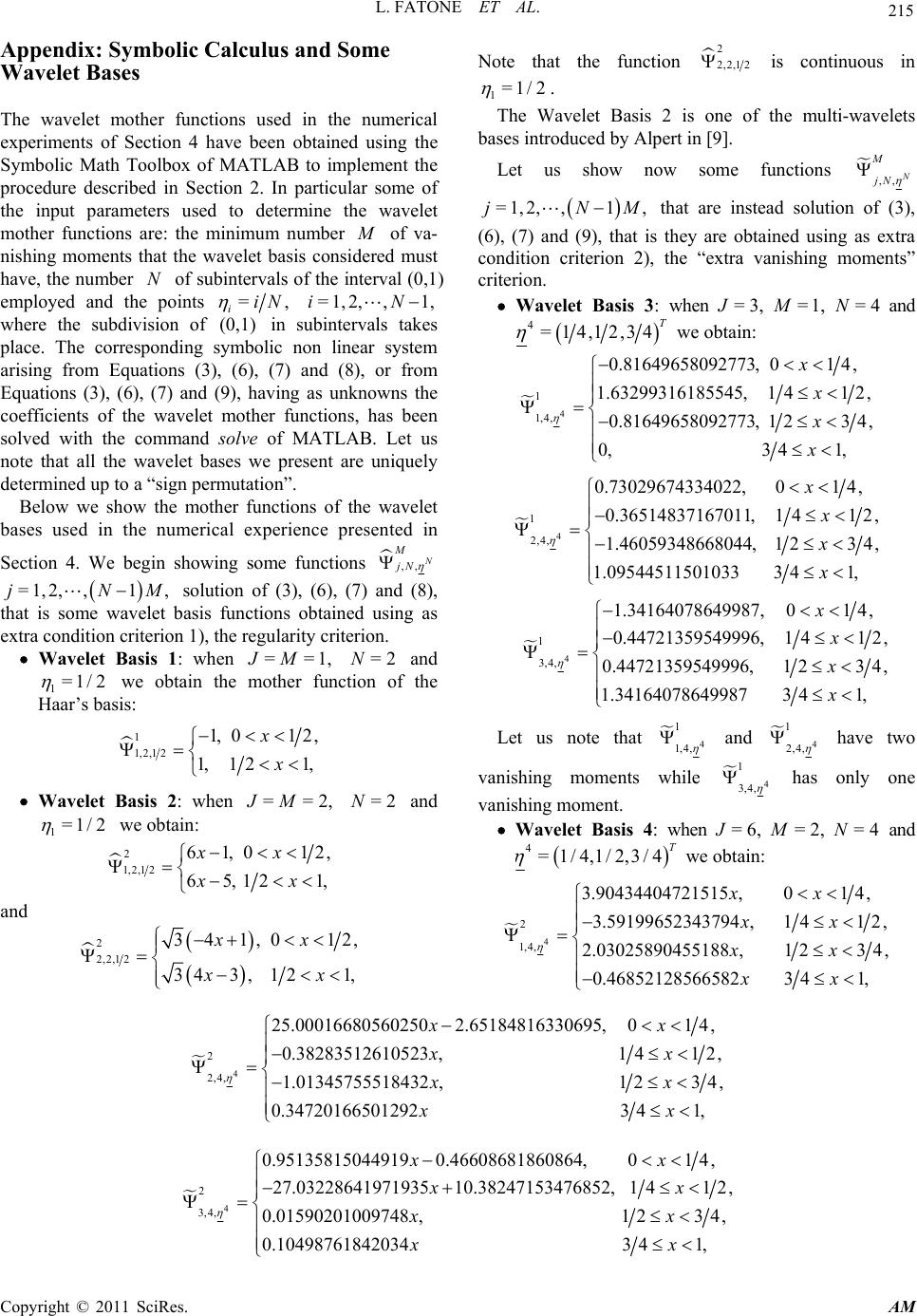 L. FATONE ET AL. Copyright © 2011 SciRes. AM 215 Appendix: Symbolic Calculus and Some Wavelet Bases The wavelet mother functions used in the numerical experiments of Section 4 have been obtained using the Symbolic Math Toolbox of MATLAB to implement the procedure described in Section 2. In particular some of the input parameters used to determine the wavelet mother functions are: the minimum number M of va- nishing moments that the wavelet basis considered must have, the number N of subintervals of the interval (0,1) employed and the points =, iiN =1,2,,1,iN where the subdivision of (0,1) in subintervals takes place. The corresponding symbolic non linear system arising from Equations (3), (6), (7) and (8), or from Equations (3), (6), (7) and (9), having as unknowns the coefficients of the wavelet mother functions, has been solved with the command solve of MATLAB. Let us note that all the wavelet bases we present are uniquely determined up to a “sign permutation”. Below we show the mother functions of the wavelet bases used in the numerical experience presented in Section 4. We begin showing some functions ,, N M jN =1,2,,1,jNM solution of (3), (6), (7) and (8), that is some wavelet basis functions obtained using as extra condition criterion 1), the regularity criterion. Wavelet Basis 1: when ==1,JM =2N and 1=1/ 2 we obtain the mother function of the Haar’s basis: 1 1,2,1 21,012 , 1,121, x x Wavelet Basis 2: when ==2,JM =2N and 1=1/ 2 we obtain: 2 1,2,1 261,0 12, 65,12 1, xx xx and 2 2,2,1 2341,012, 343, 121, xx xx Note that the function 2 2,2,1 2 is continuous in 1=1/2 . The Wavelet Basis 2 is one of the multi-wavelets bases introduced by Alpert in [9]. Let us show now some functions ,, N M jN =1,2,,1,jNM that are instead solution of (3), (6), (7) and (9), that is they are obtained using as extra condition criterion 2), the “extra vanishing moments” criterion. Wavelet Basis 3: when = 3, J =1,M =4N and 4=14,12,34 T we obtain: 4 1 1,4, 0.81649658092773,01 4, 1.63299316185545,141 2, 0.81649658092773,1 234, 0,3 41, x x x x 4 1 2,4, 0.73029674334022,01 4, 0.36514837167011,1412, 1.46059348668044,1 234, 1.095445115010333 41, x x x x 4 1 3,4, 1.34164078649987,01 4, 0.44721359549996,141 2, 0.44721359549996,1 234, 1.341640786499873 41, x x x x Let us note that 4 1 1,4, and 4 1 2,4, have two vanishing moments while 4 1 3,4, has only one vanishing moment. Wavelet Basis 4: when = 6, J =2,M =4N and 4= 1/4,1/2,3/4 T we obtain: 4 2 1,4, 3.90434404721515,01 4, 3.59199652343794,141 2, 2.03025890455188,1 234, 0.468521285665823 41, xx xx xx xx 4 2 2,4, 25.000166805602502.65184816330695,01 4, 0.38283512610523,141 2, 1.01345755518432,1 234, 0.347201665012923 41, xx xx xx xx 4 2 3,4, 0.951358150449190.46608681860864,01 4, 27.0322864197193510.38247153476852,141 2, 0.01590201009748,1 234, 0.104987618420343 41, xx xx xx xx 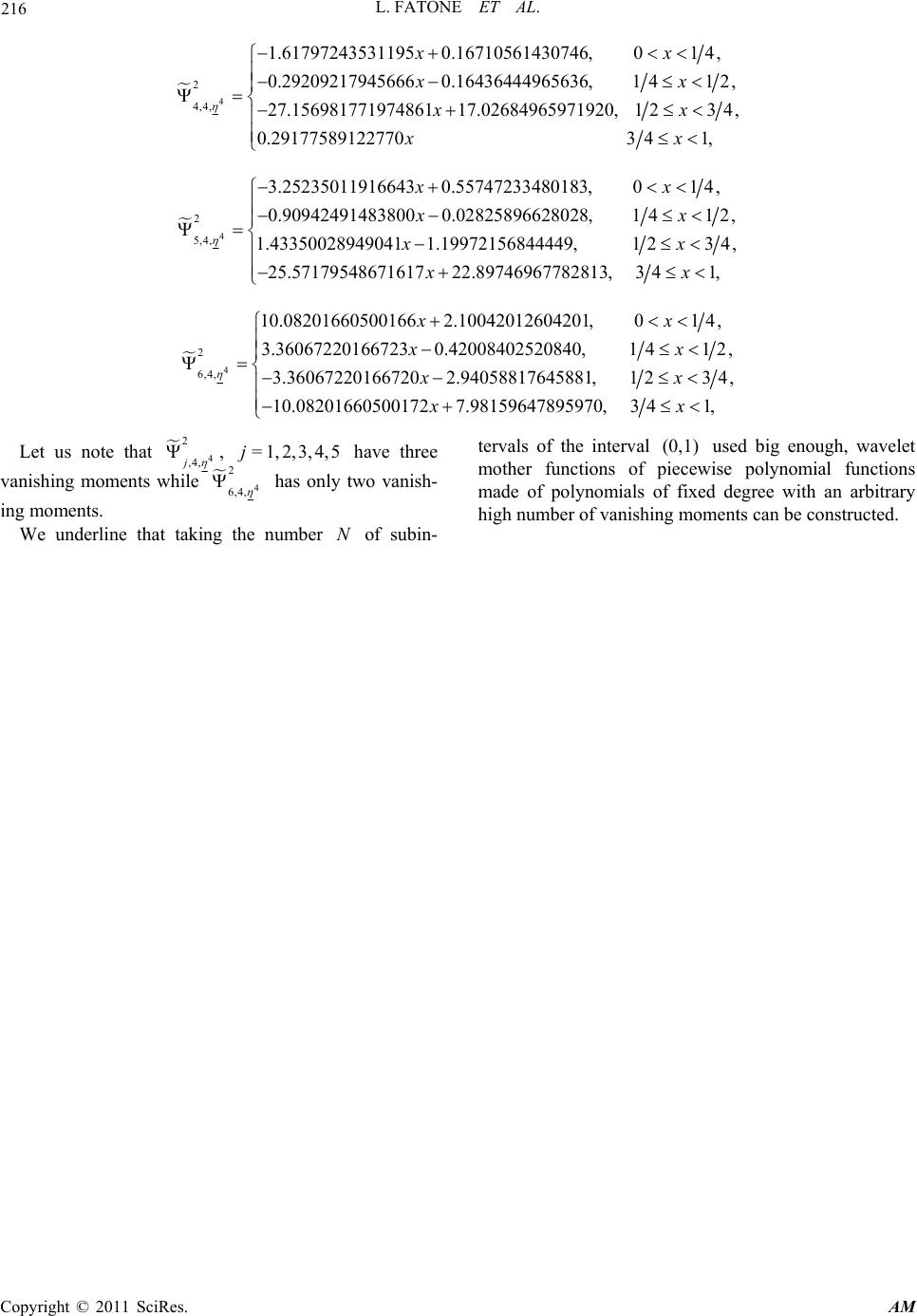 L. FATONE ET AL. Copyright © 2011 SciRes. AM 216 4 2 4,4, 1.617972435311950.16710561430746,01 4, 0.292092179456660.16436444965636,1412, 27.15698177197486117.02684965971920,1 234, 0.291775891227703 41, xx xx xx xx 4 2 5,4 , 3.252350119166430.55747233480183,01 4, 0.909424914838000.02825896628028,141 2, 1.433500289490411.19972156844449,1 234, 25.5717954867161722.89746967782813,3 41, xx xx xx xx 4 2 6,4, 10.082016605001662.10042012604201,01 4, 3.360672201667230.42008402520840,141 2, 3.360672201667202.94058817645881,1 234, 10.082016605001727.98159647895970,3 41, xx xx xx xx Let us note that 4 2 ,4, j , = 1,2,3,4,5j have three vanishing moments while 4 2 6,4, has only two vanish- ing moments. We underline that taking the number N of subin- tervals of the interval (0,1) used big enough, wavelet mother functions of piecewise polynomial functions made of polynomials of fixed degree with an arbitrary high number of vanishing moments can be constructed. |

